#then one day danny appears in the Wayne family home and acts as if he were tim BUT in his proper body and while tim is right there
Text
How about a fic where the Fenton portal was opened in like the 90s and so Phantom was the literal First Known Hero. Which is why he was hunted and there wasn’t any law to stop the Anti-ecto acts. And when Phantom Planet happened, he just disappeared, or retired. He went to Gotham U for uni and meets Bruce Wayne there and they hit it off as good friends and later wild romance partners who slept around. And when they graduated they separated to do their own thing but Danny returns once in awhile to visit Bruce.
They also meet randomly when Bruce goes on work trips in random countries and cities. They never mention the kids and Danny doesn’t know about Batman. Bruce doesn’t know about Phantom. He just thinks Danny is an engineer that travels for work. Which he is, but he’s also mainly the Ling of the Infinite Realms and appears in other countries and cities bc that’s conveniently where natural portals are spawning.
What Danny doesn’t know is that since he’s taken up the mantle of king, the zone has changed to match him. So it’s much more welcoming and natural portals spawn where Bruce is bc he lowkey is in love with him and just doesn’t realize it. And vice versa, Bruce is lowkey in love with Danny and they fawn over each other when they meet up without realizing that’s what’s happening. But Alfred knows, he’s known for awhile. And so does Jazz.
So when one day, Alfred brings up that Danny is in town in Gotham and Bruce says to set a time for them to meet, one of the kids hear this and they wonder who this Danny is, bc they’ve never heard his name. It becomes a Wayne Mystery when that week, Bruce is out most nights and portions of the day and comes back looking happy and soft. Which freaks everyone out and they stalk Danny and realize they’re meeting each other and this man is someone Bruce cares about a lot. So they bring him up at dinner one day and Bruce is like, oh yea he’s an old friend of mine. And when pressed on why they haven’t heard or met him, Bruce just says that they’ve never brought it up and since Danny isn’t around a lot, and Bruce is a little self aware of himself at this point, doesn’t want this relationship to affect the kids since they aren’t exclusive or together really.
So the kids plot and get Danny to come to the Manor for dinner. They then realize during dinner, watching Bruce and Danny interact, that holy shit, this is their other dad. They’re so in sync that they don’t realize it and he’s so good with the kids too and Bruce is so happy when he’s around…
Cue the batfamily kids Parent Trapping the two, with the help of Alfred who is all for it bc he likes Danny.
In the end, Danny decides to stay at the Manor and the kids can now call him other dad, or pops, or some variation. But they all collectively don’t mention the vigilante side they have, since they all figured it out themselves. Their new dad can do so too. Which then spirals when all of the kids Omar’s out on Patrol, Alfred is on Vacay, and Danny is alone in the house when Talia comes a knocking, bc she knows that Danny has always had Bruce’s heart and wants him gone. She’s always been jealous of their relationship so she tries to kill him. The family realize what’s happened when Damian sees some League members watching them on patrol and they race back home to see Danny decimating the assassins and Talia. He sees the family in their costumes and thinks, oh wow this makes all the sense now.
And they see Danny as a ghost, which Bruce recognizes as Phantom, the first hero!!!! And they all sit down and talk about it.
There’s probs more too but that’s all I have rn.
163 notes
·
View notes
Text
Dc x DP: Vague Threats
Danny Fenton gets a full ride to Gotham University, thanks to the Wayne Foundation. He won the scholarship after submitting his research on purple-back gorillas, seeing as the zoo incident had led to him wanting to study zoology after being a astronaut was out.
He was surprised that Gotham University had one of the best programs in zoology in the whole country, but that may be due to Bruce Wayne funding the whole department because his youngest loves animals.
In any case, he is expected to participate in specific requirements to keep his scholarship. Things like community service hours, GPA averages, and attendance to Wayne Galas.
Now community service isn't hard. He volunteers at an animal shelter. His GPA isnt hard, he has a 4.0 because when he cares, he is brilliant. No what's hard is the Galas.
He has to attend a total of 2. The scholarship fundraiser is unarguable, and another Gala of his choice. Danny has avoided the second one as best he can, and he knows it's to get rich people to donate so he can keep studying but the Galas are suffocating.
Mainly Danny stands in a corner invisible after the first 30 minutes, allowing himself to become visible when people start questioning where he is. He has to, otherwise he is acussed of not being there.
Danny is doing that when Bruce Wayne and his butler stop right before him and talk about the batcave.
Danny blinks, his eyebrow-raising higher and higher as they mutter details of a case. Then Bruce tells his butler to cover for him so he can go out. Danny follows and watches the man disappear down a clock, further investigation leads him to the Batcave.
So Bruce Wayne....is Batman. Huh. Welp that has nothing to do with Danny.
He returns to the party, appearing only four times, and heads home. The following morning he finds out Batman, along with Nightwing and Red Robin, had put a stop to a gang fight.
He thinks of how tired Bruce must be, and so as he's cleaning the dog cages gets an idea. He finishes his work for the day, goes to his house, and opens his miniature portal into the ghost zone to buy some teas and soap Baths.
The ghost zone products have an amazing effect on humans to help heal them faster thanks to the pure ectoplasm. He puts together a gift basket for everyone in the Wayne family- including the butler- and sends them to Wayne Manor through a ghost vulture.
He just wanted to thank them for all their hard work to keep him and the city safe. Mody Dick, knows he would have appreciated it when he was still acting as Phantom back in Amity Park.
He includes thank you letters each, including specific examples of how they have help the city both in and out of costume.
Danny then goes to his next lecture class with a pat on his shoulder. He feels so good about it, he decides to send them every other week.
Across the city, the Wayne are panicking that someone just sent them all a basket with a very vague threat of exposing their identities. They scramble to find the person who found out, but with no leads or evidence, they can only pray that whoever found them out wouldn't hurt their loved ones.
The personal threats only made them more uneasy. Are they being followed? How close have they gotten to have such details?
Tim Drake is determined to find the person responsible.
2K notes
·
View notes
Text
In Memory of Brian, Fred and Jerry by Susan King

I mourn the loss of Hollywood legends, especially those I have interviewed over the years. I broke into tears when Debbie Reynolds died four years ago, recalling our last chat together in 2016 when we did a duet of “Moses Supposes.” And I still haven’t watched TO KILL A MOCKINGBIRD (’62) since Gregory Peck died in 2003. I had the opportunity to interview the handsome Oscar-winner at his now torn down home in 1997 and 1999. He was everything you’d hope he would be – sweet, intelligent and funny. He also loved Bob Dylan. His last words to me as he walked me to my car were: “You are a most interesting young lady.”
In 2020 alone, I lost over 20 former interviewees including Kirk Douglas, whom I interviewed eight times between 1986-2017, and my beloved Olivia de Havilland, who I found to be delightful and a bit ribald in the two interviews I did with her. I got more than a little misty when Brian Dennehy, Fred Willard and Jerry Stiller died this year. They were supremely talented and made our lives a little brighter with their performances. And, they all were great guys and fun interviews.
Brian Dennehy
I interviewed Brian Dennehy, who died in April at the age of 81, several times in the early 1990s when I was at the L.A. Times. The former U.S. Marine and football player was intimidating at first sight. He was tall, burly and barrel-chested. He had a no-nonsense quality about him, and he spoke his mind. But he also was funny.

In 1991, discussing how hard it was for some actors to land parts after starring in a TV series, he noted “coming off a TV series is a tough deal, and you go into limbo land for a while, if not forever. Most actors go immediately to the ‘Island of Lost Actors’ and stay there. Troy Donahue is the mayor.” Dennehy never went to that island. Not with the complex and often memorable performances he gave in such films as FIRST BLOOD (’82), SILVERADO (’85), COCOON (’85), PRESUMED INNOCENT (’90) and as Big Tom in the comedy TOMMY BOY (’95).
He was nominated for five Emmys, including one for his chilling turn as serial killer John Wayne Gacy in the miniseries To Catch a Killer (’92).
I had one of the most extraordinary evenings at the theater in 2000 when Dennehy reprised his Tony Award-winning role as the tragic Willy Loman at the Ahmanson Theatre in Los Angeles in the lauded revival of Arthur Miller’s masterpiece Death of a Salesman. It was a gut-wrenching performance that left me emotionally exhausted. He earned another Tony in 2003 as James Tyrone in the revival of Eugene O’Neill’s superb Long Day’s Journey into Night. And he never stopped working.
Shortly after his death, the drama DRIVEWAYS (2020) was released on streaming platforms. And it could be Dennehy’s greatest performance. He plays Del, an elderly widower and Korean War vet who sparks a warm friendship with Cody, the young boy next door. The reviews for the film (it’s at 100% fresh on Rotten Tomatoes) and Dennehy have been glowing. The L.A. Times’ Justin Chang wrote that Dennehy’s Del is as “forceful and tender a creation as any in this great actor’s body of work.” And Jeannette Catsoulis of The New York Times stated: “What we might remember most, perhaps appropriately, are Dennehy’s warm, weary features and rich line readings. In a lovely final monologue, Del advises Cody to avoid rushing past the experiences in life that matter, as they pass so quickly on their own. Much like the careers of beloved actors.”
Fred Willard
I first encountered Fred Willard as the clueless sidekick of sleazy talk show host Barth Gimble (Martin Mull) in the late 1970s on the syndicated comedy series Fernwood Tonight and its continuation America 2-Night. I quickly became a fan, and that admiration grew when he became a member of Christopher Guest’s stock company of zanies in such comedies as WAITING FOR GUFFMAN (’96) and BEST IN SHOW (2000). In the latter, he played the equally clueless dog show announcer Buck Laughlin who quipped in his color commentary, “And to think that in some counties these dogs are eaten.”
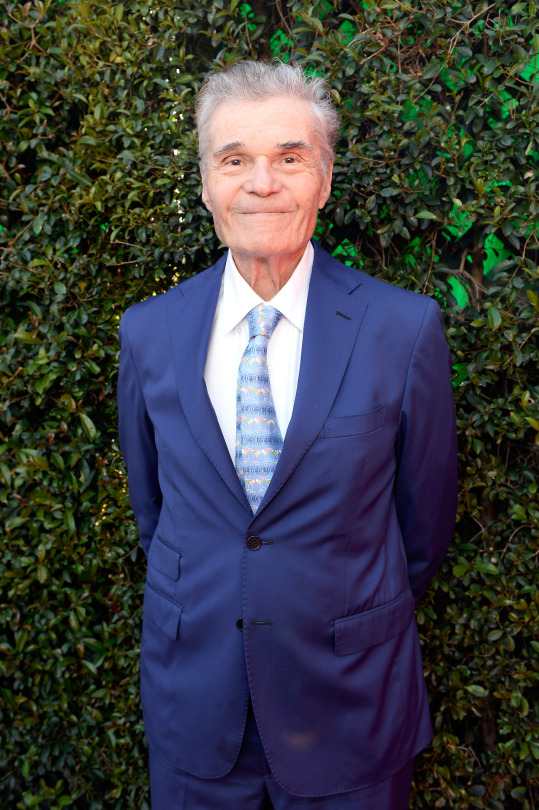
Willard told me in a 2012 L.A. Times interview that he didn’t think he was funny until he was an adult. “I always loved comedy growing up – Bob Hope, Red Skelton and Danny Kaye,” said Willard, who died in May at the age of 86.
Willard got a serious part in Tennessee Williams’ one-act in a summer theater group when he was in his 20s. “I was getting laughs on all the lines,” he noted. “The director got upset because the audiences were always laughing. I didn’t try to do it deliberately. Then I realized I would say things around people, and they would laugh. I didn’t mean to be funny. I have always been relaxed around comedy.”
Just as Dennehy, Willard kept working. In fact, he received an Emmy nomination posthumously for his hilarious turn as Ty Burrell’s goofball dad on ABC’s Modern Family. He told me he wished he could try to do more dramatic fare like in Clint Eastwood’s World War II drama Flags of Our Fathers (2006). Willard even called his agent to see if he could get a role in the movie. “Clint Eastwood’s people called back and said, ‘We love Fred, but we are afraid if he appeared on the screen, they might start to laugh.’’’
Jerry Stiller
Jerry Stiller was a real sweetie and also very thoughtful. He sent me a lovely thank you note when I interviewed him and his wife, Anne Meara, in the early 1990s. When I talked to him for his son Ben Stiller’s remake of THE HEARTBREAK KID (2007), Stiller sent me a lovely bouquet of flowers. Ditto in 2010 when I interviewed the couple for a Yahoo! Web series Stiller & Meara: A Show About Everything. I also received Christmas cards until Meara died in 2015.

Baby boomers remember Stiller, who died at 92 in May, and Meara for their smart and sophisticated comedy act, in which the majority of the humor came from the fact that he was Jewish and she was born Irish Catholic. They recorded albums, were popular on the nightclub circuit and did The Ed Sullivan Show three dozen times. They split up their act when musical variety series went away.
Both were terrific dramatic actors. In fact, I saw Stiller in the 1984 Broadway production of Hurlyburly, David Rabe’s scathing look at Hollywood, and he did a 1997 production of Chekhov’s The Three Sisters. Of course, Stiller garnered even more success in his Emmy-nominated role as Frank Costanza, the caustic father of George (Jason Alexander) on NBC’s Seinfeld (1993-98) and was the best reason to watch CBS’ sitcom The King of Queens (1998-2007) as Kevin James’ acerbic father-in-law
But I most remember that 2010 interview where Stiller and Meara bantered back and forth much to my enjoyment. Here they talk about Ed Sullivan:
Anne: I never liked him.
Jerry: You are out of your mind. You never liked him?
Anne: He scared stuff out of me. I am talking about Mr. Sullivan himself. I wasn’t the only one. There were international favorites throwing up in the wings—singers and tenors and guys who spin plates. It was live. We were scared.
Jerry: Ed Sullivan brought us up to the level that we knew we never could get to – him standing there on the right side of the wings laughing, tears coming out of his eyes and then calling us over and saying, ‘You know, we got a lot of mail on that last show you did.’ I said, ‘From Catholic or Jewish people?’ He said, ‘The Lutherans.’”
#Jerry Stiller#brian dennehy#in memoriam#Fred Williard#Ben Stiller#TCM Classic Film Festival#LA Times#Susan King#TCM#Turner Classic Movies#comedians#actors
138 notes
·
View notes
Text
Tim’s Complicated School History
So I’ve noticed there seems to be a fair bit of confusion on where Tim went to high school, whether he dropped out or not, if he went to private or public school, etc., so I thought I’d create a general chronology of (Pre-Flashpoint) Tim’s tumultuous high school career. The confusion about this is deserved, as Tim has literally gone to no less than FIVE high schools and also homeschooled for a bit, so it’s a LOT to keep track of. Tim has attended both private schools and public schools, and has gone to school in Gotham and Bludhaven (and almost Keystone!), ultimately ending his school days when he dropped out of Gotham City High School during his senior year to go search for Bruce after the events of Final Crisis.
Here’s the breakdown:
Pre-High School: Tim attended private boarding schools until he was about 13-14 years old. To my knowledge these schools are never specifically named, but 13-yr-old Tim mentions in Batman #441 that he attends a boarding school just outside Gotham. In Robin III #4 Tim angrily tells his dad that him and Janet “shipped [Tim] from one boarding school to another and nobody paid any attention as long as [his] grades stayed high.” This seems to imply that Tim attended a number of different boarding schools, when there’s really no reason for him to have attended more than two (an elementary and middle school), and even then a number of private boarding schools are actually K-8 (if not K-12) so I don’t know why he attended so many schools?? Nevertheless, from K-8 Tim attended private boarding schools, primarily in the Gotham area presumably.
Tim was probably still in middle school in his earliest appearances (Batman: A Lonely Place of Dying, Batman: Rite of Passage, etc), but he starts high school right around the time he finishes his Robin training (around the time of the first Robin miniseries).
High School #1---Gotham Heights High School: The first reference to Tim being in high school comes from the 1991 Robin II miniseries. Tim has recently started at Gotham Heights High School as a ninth grader. This comic takes place after Tim’s parents were kidnapped and poisoned, and so while Jack is in the hospital Bruce is acting as a guardian of sorts for Tim. It’s at Gotham Heights that Tim befriends Sebastian Ives, as well as his friends Hudson and Callie Evans. When Ives asks Tim about the fact that he seems too rich for public school, Tim explains that he used to go to private school but that Bruce had him transferred into public school because he thought it would be “more broadening.” Even after Jack gets out of the hospital he allows Tim to stay at Gotham Heights HS, although Jack clearly has a low opinion of public schools. Tim presumably started at Gotham Heights HS at the beginning of the ninth grade and attended for about a year and a half.
Interlude---Keystone: After the events of Cataclysm, Tim’s family moves to Keystone to avoid the chaos going on in Gotham. (They only end up staying a few weeks at the most, but they moved with the intention of living there permanently, meaning that Tim was transferred out of Gotham Heights HS.) In Robin #63 Jack mentions trying to get Tim into Keystone Academy, but that it’s tough in the middle of the school year and that he was working on getting him a tutor in the interim. Tim was supposed to meet his new tutor the same day that he went back to Gotham to be with Steph while she had her baby. He left without telling his dad, and so Jack and Dana come back to Gotham to get him and they all decide to stay in Gotham after all. It’s unclear if Tim returns to Gotham Heights HS briefly or if he just doesn’t return to school until he’s enrolled at Brentwood.
High School #2---Brentwood Academy: After the events of No Man’s Land, Tim is enrolled in Brentwood Academy, a boarding school in Bristol Township (a wealthy suburb directly to the north of Gotham, where the Drakes and the Waynes both live). After missing so much school, Jack forces Tim to go to a boarding school so that his grades will hopefully come up. (I think the reasoning here is that if Tim lives at school then he’ll have no good excuse for missing class?) In Robin #75 Tim refers to himself as a “new sophomore,” and he transferred to the school some time after sophomore year started (almost definitely after winter break, but I can’t find an issue that confirms this?) but before spring break. Tim’s main friends at Brentwood are his first roommate Ali, his second roommate Wesley, and his classmates Buzz, Kip, and Danny. Tim isn’t at Brentwood for very long though. After only a few months (maybe even less) of Tim being at Brentwood, Jack finds out he’s lost a good portion of the Drake family fortune in bad investments. He’s forced to withdraw Tim from school as he can’t afford the tuition anymore, and the Drakes sell their home in Bristol Township and move into their townhouse in inner-city Gotham.
Interlude---Rest of Sophomore Year: When Tim left Brentwood it was rather late in the year, and it was apparently too late to re-enroll him in public school, so he took the rest of the school year off. That summer he has to take a placement test that will keep him from having to repeat the 10th grade. He passes, so when he re-enters public school he does so as a junior.
High School #3---Louis E. Grieve Memorial High School: Tim starts his junior year at Louis E. Grieve Memorial HS, where he quickly befriends Bernard Dowd and Darla Aquista. He doesn’t attend school here very long, probably for about 3-4 months (he’s only been at Grieve Memorial HS for a few weeks when he’s forced to quit being Robin, Steph takes over for about 2 months, and then it’s only another couple weeks until the events of War Games). During War Games, Tim’s friend Darla is targeted by several mobs (because her father is an Italian mob boss) and mobsters take over his school and end up killing several students, Darla included. Darla’s funeral is one of three that Tim has to attend in as many days, his dad being killed during Identity Crisis and Steph “dying” at the end of War Games.
High School #4---John Wayne High School, Bludhaven: After War Games and Identity Crisis, Tim moves to Bludhaven to try for a fresh start. He picked Bludhaven specifically for an in-patient facility that will help his stepmom, Dana, process her grief over Jack’s death. Tim moves to be close to her and starts attending John Wayne High School. He probably only attends for about two weeks though, before he has his (fake) Uncle Eddie withdraw him from the school to start homeschooling. Tim withdraws with the intention of homeschooling until he can test out of school early. But it isn’t long (maybe another month or so) until Infinite Crisis, and then Tim and Dick go on a nearly year-long training journey with Bruce.
Interlude---OYL: During the missing year* between Infinite Crisis and One Year Later, Tim isn’t in school at all, as he and Dick and Bruce are travelling the world and training.
(*Also, with the nightmare that is comics continuity and the passage of time, Tim really couldn’t have been gone for more than like,,,,6-8 months, as it was late winter/early spring when Infinite Crisis happened---at least according to the Robin series---and it’s summer when he returns to Gotham. He’s still 17 early in the Red Robin series so it couldn’t have been a year and a half that he was gone, therefore he could only have been gone for like half a year.)
High School #5---Gotham City High School: After the OYL time jump, Tim starts attending Gotham City High School. He starts during the “summer session” (presumably to make up for the semester he missed during OYL?) before his senior year. His main friends here are Zoanne Wilkins (who he starts dating), Jared Walton, Craig Pulaski, and then both Ives and Steph transfer to GCHS during Tim’s senior year (altho Steph is usually a year older than Tim in Pre-52 canon, so it really makes no sense for her to be there??). This is the high school Tim is attending when he drops out of school in his senior year to travel the world looking for Bruce. In Red Robin #17, Tim and Ives meet for lunch (after Bruce has returned and Tim has moved back to Gotham) and Ives mentions Tim not finishing senior year. Tim asks Ives how senior year is going---implying that the events of the first arc of Red Robin only take a few months---and catches up on how Ives and Zoanne are doing.
Some general Tim school stuff: Tim is a very smart kid, but not a very good student. In the Robin III miniseries both Jack and Tim’s school counselor make reference to the fact that before high school Tim had always been a straight A student, but that his grades and attendance have slipped considerably. He is routinely too tired to pay attention in class, he’s constantly missing weeks of school, he fails to complete homework assignments bc of Robin missions, etc. Several times he even references in his inner monologue that he thinks he might fail a specific class. And honestly, Tim just doesn’t care about school. He often makes irritable inner-monologue comments about preferring practical application over learning things in a school setting, he tries to get himself out of school permanently when he lives in Bludhaven, etc. That being said, he’s never been noted to actually fail a class and even with all the school he’s missed he’s never had to be held back, so presumably he’s still earning like Cs in most classes.
#tim drake#timothy drake#robin#batfam#meta#dc comics#our posts#i hope this is useful#i plan on making more of them at some point
457 notes
·
View notes
Photo

Little Richard. Prime force of rock’n’roll who made an explosive impact with songs such as Tutti Frutti, Good Golly, Miss Molly, Lucille and Long Tall Sally
Little Richard, who has died aged 87, was the self-proclaimed king of rock’n’roll. Such was his explosive impact that many of the baby boom generation will vividly recall the moment when they first encountered his assault on melody.
Awopbopaloobop alopbamboom! That first hit, Tutti Frutti, released in October 1955, was wild, delicious gibberish from a human voice as no other, roaring and blathering above a band like a fire-engine run amok in the night. We glimpsed a new universe. The Sinatra-sophisticats were slain with a shout. Enter glorious barbarity, chaos and sex. With a few others – Fats Domino, Bill Haley, Elvis Presley, Chuck Berry, Jerry Lee Lewis and Buddy Holly – Little Richard laid down what rock’n’roll was to be like, and he was the loudest, hottest and most exhibitionist of them all.
Richard Wayne Penniman was born in Macon, Georgia, one of 12 children of Charles, a bricklayer, and his wife Leva Mae Stewart. His family were Seventh-day Adventists and Richard learned the piano and sang gospel in the local church choir, but was thrown out of the family home at 13. He performed in medicine shows - with “miracle cures” promoted between entertainment acts – before hitching to Atlanta, where he signed to RCA Records in 1951, using the name Little Richard.
He recorded several undistinguished singles for them, including Every Hour (1951), but none had much impact. His optimism undimmed but his style still unformed, he tried the independent Peacock label in Houston, recording sides on which he began to reveal a delicate, elaborately filigreed vocal style that would resurface years later on slow gospel numbers. This same style would sometimes ornament his rock sides too, as on She’s Got It (1957), where that “got” is twiddled into 10 syllables.
These Peacock sides brought no success, and at the beginning of 1955 – the year that was to end in triumph for him – he returned to Macon and to washing dishes. He sent a demo to another indie label, Specialty, whose owner, Art Rupe, soon became so sure that Little Richard defined the future that he rejected Sam Cooke as too pallid.
Brought to New Orleans in September and given almost the same band as Fats Domino, Penniman went into the studio with the producer Bumps Blackwell, and came out with Tutti Frutti. The single was a hit with black and white audiences and sold 500,000 copies – despite the popularity of Pat Boone’s cover version released shortly afterwards – and reached 17 in the US pop charts and No 2 on the R&B list.
A cascade of frantic but tight hits followed, establishing Little Richard as a prime force in rock’n’roll. His piano work, crucial to his sound, was limited to hammered chords and skitterish riffing (he did not even play it himself on Tutti Frutti) but with that megaphone voice, falsetto squeal, bursting energy and powerhouse band, his records became classics: songs every local group played every weekend for years to come; songs the other rock greats covered; songs that fired the ambition of those artists who would change the 1960s, the Beatles and Bob Dylan.
Long Tall Sally, Slippin’ and Slidin’, Rip It Up, Ready Teddy, She’s Got It and The Girl Can’t Help It were all released in 1956. The following year, Little Richard recorded Lucille, Send Me Some Lovin’, Jenny, Jenny, Miss Ann, and the awesome Keep A-Knockin’. And 1958 produced the last great batch: Good Golly Miss Molly, True Fine Mama and a glorious pillage of the music-hall oldie Baby Face.
It is obvious now from the titles alone that a formula soon set in with these records. Back then though, it was just how Little Richard was: an unstoppable force. Within the flailing combustion of True Fine Mama we now recognise a conventional 12-bar blues; at the time we heard formless galactic meltdown. Similarly, we now see that his presentation was partly “outrageous queen”, his catchphrase “Ooh ma soul” pure camp. But these were cliches from the future. When rock’n’roll and Little Richard were new, his preening, boasting and benign lasciviousness seemed highly individual.
He was an inspiration to younger black musicians with white audiences. The young guitarist Jimi Hendrix learned a lot from backing Little Richard on tour; and as Richard once observed of Prince, “the little moustache, the moves, the physicality – he’s a genius but he learnt it from me. I was wearing purple before he was born; I was wearing make-up before anyone else.”
His sexuality was no simple thing. As he revealed in his candid autobiography, The Life and Times of Little Richard (1984, as told to Charles White), he fancied men and women, but most of all he fancied himself.
However, touring Australia in 1957, he threw his rings off Sydney Harbour bridge, renouncing the devil’s music for God. The performer who had once said of gospel that “I knew there had to be something louder, and I found it was me” now divided his time between bible school in Alabama and the Seventh-day Adventist church in Times Square, New York. He met his wife, Ernestine Campbell, at an evangelical rally in October of that year. They married in 1959 but divorced four years later.
Specialty kept the hits coming until 1959, when the long line ended with a game By the Light of the Silvery Moon. An era was over. Elvis had been drafted, Holly was dead. With God on his side, and Quincy Jones producing, Little Richard made the religious album It’s Real, for Mercury Records, billing himself “king of the gospel singers”. A 1962 single, He Got What He Wanted (But He Lost What He Had), fused old and new, its parables sung in vintage style: a steaming, raging, funny tour de force to equal Long Tall Sally. It was a minor hit.
He returned to rock’n’roll and Specialty, recorded Bama Lama Bama Loo (1964), and played Britain with the Rolling Stones, Bo Diddley and the Everlys. As the rock critic Nik Cohn testified, “he cut them all to shreds”. While in the UK he also made a TV special with the Shirelles (It’s Little Richard, 1964) – one of the rare times when rock was truly exciting on television.
I saw him live in this period, backed by the instrumental group Sounds Incorporated. He never paid them a moment’s attention, and was magnificent. When he stood on top of the piano, took off a ring and threw it into the audience, even those of us at the back with no chance of getting within a 100ft dived forward, hypnotised by this consummate artist.
But while the debut record from the 60s soul king Otis Redding was titled Shout Bamalama, Little Richard himself slid through failed comebacks, vainglorious live theatrics and indifferent re-recordings.
Exceptions included fine versions of Lawdy Miss Clawdy (1964) and Bring It on Home to Me (1966), while 70s covers of the Beatles’ I Saw Her Standing There and the Stones’ Brown Sugar emphasised how much he had inspired those bands in the first place. Attempts to update himself brought small success and in 1976 he retreated back to religion. By the decade’s end he was a late but rapacious convert to drug abuse.
In the 80s, however, the world and Little Richard were ready for each other again, and in 1986 he appeared, smiling with Hollywood good health, in the hit film Down and Out in Beverly Hills. It says much for his unquenchable charm that so soon after his upfront autobiography he could remake himself as a Disney favourite, with an album of children’s songs and a TV series, on which a revisited Keep A-Knockin’ incorporated knock-knock jokes swapped with his new young audience.
In 1993, the 60-year-old gospeller had supposedly found Judaism but was also rock’n’rolling again. In 1996, wavy hair down his back, he was to be seen playing on a truck at the closing ceremony of the Atlanta Olympics, and, as gloriously incongruous as ever, in an episode of Baywatch, performing on the boardwalk, his eerily plastic-smooth face that of a 35-year-old.
Little Richard became embedded in showbiz, appearing frequently on American television, in roles and as himself, including as a judge on Simon Cowell’s Celebrity Duets in 2006. He voiced a Disney World pineapple, saw his hits recycled in ads and films, was the subject of a 2000 biopic, and recorded anew with partners from Bon Jovi to Elton John. As a preacher, he conducted weddings for celebrities including Bruce Willis and Demi Moore, and spoke at the funerals of Wilson Pickett and Ike Turner.
Gaining multiple awards for his pioneering early work, he was among the first to be inducted into the Rock and Roll Hall of Fame, in 1986, and received a lifetime achievement Grammy in 1993. Little Richard needed none of these awards or hall of fame citations to tell him who he was or what he had achieved. He knew that all along. He was one of the gods, and almost the last among them.
His health declined in the 2000s, and he had heart surgery in 2008, cancelling a planned European tour with Berry. In 2009 he had hip replacement surgery, after which he still performed, yet giving audiences the novelty of seeing him seated at the keyboards.
In 2013 he announced his retirement. His last appearance was while attending the ceremony at which he received the Distinguished Artist award at the 2019 Tennessee Governor’s Arts Awards in Nashville.
He is survived by a son, Danny.
• Little Richard (Richard Wayne Penniman), singer-songwriter, born 5 December 1932; died 9 May 2020
Daily inspiration. Discover more photos at http://justforbooks.tumblr.com
25 notes
·
View notes
Text
VAN DYKE & COMPANY
December 9, 1976 (S1;E9)

Directed by John Moffitt
Written by George Burditt, Garry Ferrier, Ken Finkelman, Mitch Markovitz, Don Novello, Pat Proft, Leonard Ripps, Mickey Rose, Aubrey Tadman, Paul Wayne, Dick Van Dyke

Dick Van Dyke (Himself, Host / Various Characters) was born Richard Wayne Van Dyke in West Plains, Missouri, in 1925. Although he'd had small roles beforehand, Van Dyke was launched to stardom in the 1960 Broadway musical Bye Bye Birdie, for which he won a Tony Award. He reprised his role in the 1963 film. He has starred in a number of other films throughout the years including Mary Poppins (1964) and Chitty Chitty Bang Bang (1968). From 1961 to 1966 he played TV writer Rob Petrie in “The Dick Van Dyke Show.” He also starred in “The New Dick Van Dyke Show” (1971-74), “Van Dyke & Company” (1976), and “Diagnosis Murder” (1993-2001).
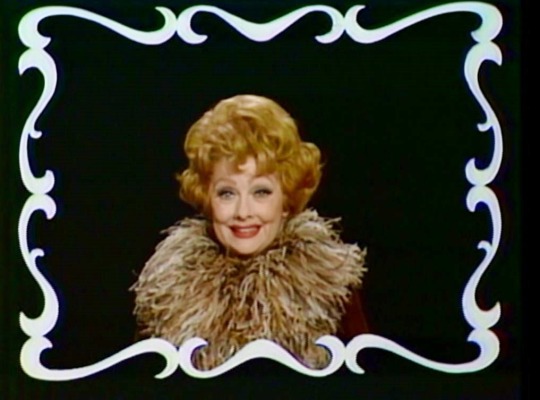
Lucille Ball (Herself, Various Characters) was born on August 6, 1911 in Jamestown, New York. She began her screen career in 1933 and was known in Hollywood as ‘Queen of the B’s’ due to her many appearances in ‘B’ movies. With Richard Denning, she starred in a radio program titled “My Favorite Husband” which eventually led to the creation of “I Love Lucy,” a television situation comedy in which she co-starred with her real-life husband, Latin bandleader Desi Arnaz. The program was phenomenally successful, allowing the couple to purchase what was once RKO Studios, re-naming it Desilu. When the show ended in 1960 (in an hour-long format known as “The Lucy-Desi Comedy Hour”) so did Lucy and Desi’s marriage. In 1962, hoping to keep Desilu financially solvent, Lucy returned to the sitcom format with “The Lucy Show,” which lasted six seasons. She followed that with a similar sitcom “Here’s Lucy” co-starring with her real-life children, Lucie and Desi Jr., as well as Gale Gordon, who had joined the cast of “The Lucy Show” during season two. Before her death in 1989, Lucy made one more attempt at a sitcom with “Life With Lucy,” also with Gordon, which was not a success and was canceled after just 13 episodes.

The Lockers was a male lock dance troupe first known as the Campbell Lockers formed by Toni Basil and Don Campbell in 1971. They were pioneers of street dance. They appeared on “The Tonight Show,” “Saturday Night Live,” and “What's Happening!!” This is their final TV appearance.
Andy Kaufman (Andy) was a performance artist and comedian. He is best known for playing Latka Gravas on the TV sitcom “Taxi.” Andy appeared in movies, on Broadway, did a one man show at Carnegie Hall, enjoyed a brief professional wrestling career, and performed in concerts nationwide. He died in 1984 of lung cancer.
Kaufman is not credited in the opening title sequence nor in the closing voice over credits. This was likely to lend veracity to his continual habit of ‘crashing’ the show and interrupting Van Dyke's guests.
L.A. Mime Company
John Wheeler (Mr. Haley, Network Executive) was in the New York stage productions of Wonderful Town (also on TV in 1958) and Sweet Charity (also the film 1969). He was seen opposite Lucille Ball as Judge Breghoff in the movie Mame. He appeared on one episode of “Here's Lucy” (S6;E16) in 1974. Coincidentally, he played Fred Mertz in the TV film “Lucy and Desi: Before the Laughter” in 1991.
Barry Van Dyke (Honey #2 / Helen's Paramour) was Dick Van Dyke's son born in July 1951, just two weeks after Lucie Arnaz. Like Lucie, he made his screen debut on his parent's TV show in 1962 and went on to larger roles in subsequent series'. Probably his most famous of those roles was as Steve Sloan in “Diagnosis Murder” (1993-2001).
It is a bit odd that Van Dyke's real son is playing (who is inferred to be) his male lover in the “Honey, I'm Home” sketch.
Judy Von Wormer had played one of the singers in “Lucy, The Co-Ed” (HL S3;E6) in 1970.
Brian Bruno and Barney, The Paul Family
Stu Nahan (Announcer)

“Van Dyke & Company” was a short-lived variety show that aired on NBC from September 20, 1976 to December 30, 1976. A pilot episode was shot in October 1975, but the series did not debut for another 11 months.

In a 1965 appearance on “Art Linkletter's House Party” Lucille Ball said that “The Dick Van Dyke Show” was her favorite television program. The series was shot at Desilu Studios. It took 11 years for Van Dyke and Ball to collaborate. This is the first time Ball and Van Dyke have acted opposite each other, although the two had appeared as guests on “Salute to Stan Laurel” in 1965.
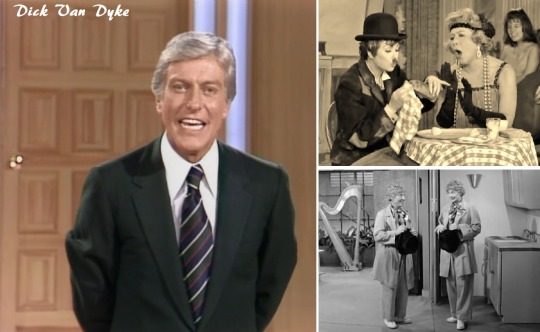
A week before her appearance on “Van Dyke & Company,” Dick Van Dyke appeared on “CBS Salutes Lucy: The First 25 Years” paying tribute to Lucy's skill at pantomime (something both were adept at and demonstrate here) from the set of his show. In 2001, Van Dyke co-hosted “I Love Lucy's 50th Anniversary Special.”

Genealogists claim that Lucy and Van Dyke are distant relatives. They are 10th cousins, once removed.
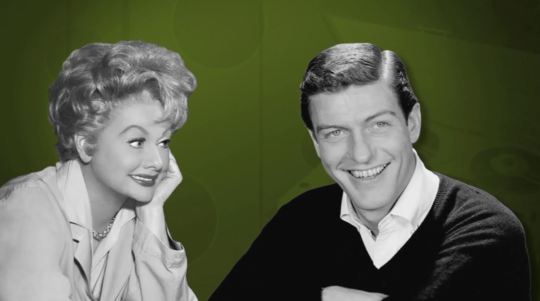
This episode of “Van Dyke & Company” was aired by MeTV on August 6, 2017 (Lucy's birthday). The entire series is available on DVD from MPI Video. Bonus features include audio from Van Dyke as a guest on “Let's Talk to Lucy,” Ball's 1964-65 radio show. For this episode, only Andy Kaufman's Elvis impersonation has been omitted, likely due to royalty restrictions.
On December 15, 1976, less than a week after this episode of “Van Dyke & Company” aired, Lucille Ball was on the dais for “The Dean Martin Celebrity Roast” of Danny Thomas.
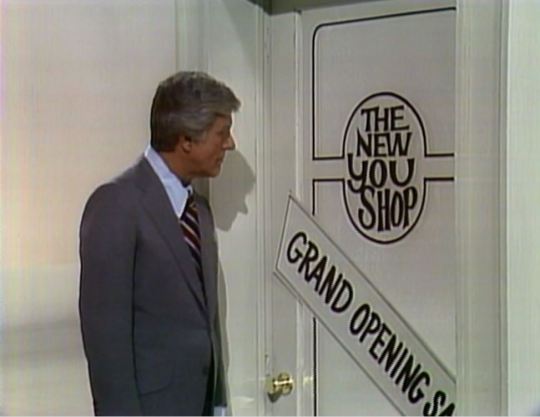
A cold open (pre-credits) has Dick paying a visit to the grand opening of “The New You Shop” staffed by Lucy, in a wordless physical comedy sketch. The premise has Lucy selling new 'body parts' (invisible and pantomimed with the help of sound effects) such as legs, chests, hands, faces, and feet.

Trying on the parts inside 'The New You Machine', something goes horribly wrong. Dick emerges with arms that scrape the ground and a hand on the end of his foot!

In Dick's monologue he demonstrates the differences in the family hour format as opposed to later time slots using a fictional show called “Honey, I'm Home.” The Family Viewing Hour was a policy established by the Federal Communications Commission (FCC) in 1975. Under the policy, each television network had the responsibility to air "family-friendly" programming during the first hour of the prime time lineup (8 to 9 pm Eastern Time). “Van Dyke & Company” occupied the ‘Family Hour’ time slot.
“Honey, I'm Home” 8pm to 9pm ('Family Hour') – Dick comes home to find his wife waiting patiently on the sofa.
“Honey, I'm Home” 9pm to 10pm – Dick comes home to find his wife kissing another man.
“Honey, I'm Home” 10pm to 11pm – Dick comes home to find the same couple looking at a road map, but the 'honey' he's come home to is the man, not the woman!
He attempts to show the audience “Honey, I'm Home” after midnight, but quickly opens and shuts the door, horrified at what he's seen (and we don't).
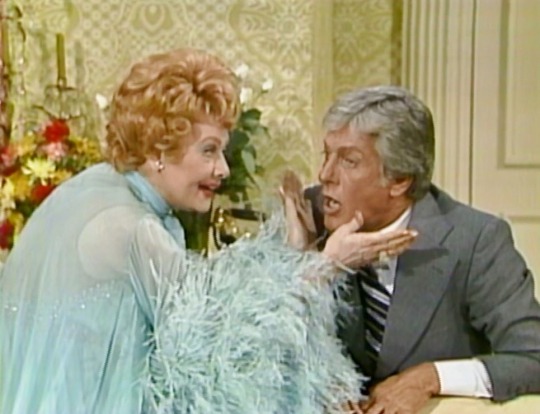
A network executive (John Wheeler) appoints Richard (Dick) to Vice President of Programming in order to get him to tell fading star Marion Lane (Lucy) that her show has been canceled. Lucy receives a big ovation from the studio audience, which indicates this may be the first segment shot, with the cold open pre-taped without a studio audience.
Marion seems to know what he's come for and quickly takes a liberal amount of tablets.
Richard: “Marion, what's that you're taking?”
Marion: “Sleeping pills.”
Richard: “Wouldn't you call that a kind of a heavy dose?”
Marion: “I'd call it an overdose.”
Turns out they were just breath mints. Still fearing the worst, Marion momentarily straddles an open window. When he finally delivers the bad news, she slaps him hard across the face, sending him careening over the divan. The sketch has a surprise twist ending with Richard being Marion's husband!

Dick is discovered chiseling a sculpture and telling the audience that he's always wanted Rudolf Nureyev as a guest. He finally got a call from the dancer to tell him that he will be appearing – on “The Gong Show.” “The Gong Show” was a low-budget amateur talent show that had only premiered on TV a few months earlier. This set-up is by way of introducing what Dick calls “the most fabulous dancers around” - The Lockers. After they perform their main act, Dick joins in, even wearing one of their costumes.
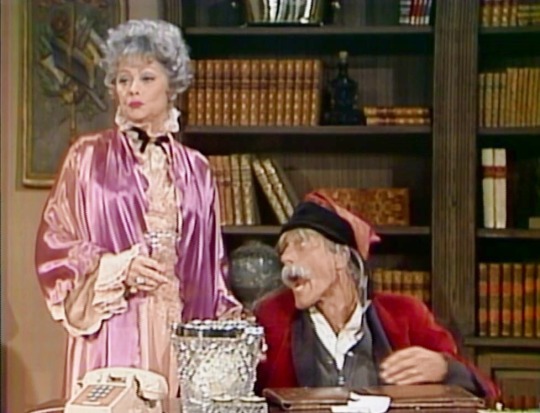
Dick and Lucy play Helen and Edgar, a couple celebrating their 40th anniversary. Edgar is 115 years old, and Helen is 75. She only married him thinking she would soon be a rich widow. Van Dyke's characterization of Edgar is reminiscent of when he played the elderly banker Mr. Dawes Sr. in Mary Poppins (1964). Helen tries everything she can think of to hasten her inheritance.
She cracks a champagne bottle on his head. Nothing.
She tries to guillotine him while blowing out the candles on their anniversary cake. It misses.
She gives him a big anniversary kiss with an electrified wire. He is energized by it.
She offers him some fresh air out on the balcony (which they don't have) and pushes his wheelchair headlong out the terrace doors. Helen thinks she's finally succeeded in offing him, but he comes rolling through the opposite door a few moments later, his wheelchair now a mash-up of a trash can and mobility device.
Helen finally slips Edgar a mickey that does the trick – but first he calls up the newspaper to place his own obituary. The sketch has a twist ending with the entrance of Helen's paramour (Barry Van Dyke), who may be trying to do the same thing to her!

Dick and Lucy are having some banter as themselves when Andy Kaufman arrives with his tape player wanting to be on the show. Although Dick says that Andy should just go away, Lucy says that she's seen Andy on the show before, and that he always interrupts guests, and they've all been very good sports about it. Lucy says that she just doesn't happen to be one and swiftly exits. Dick says Andy has previously insulted Carl Reiner (S1;E4), Hal Linden (S1;E5), John Denver (S1;E3), and now Lucy. Dick exits to find a security guard.
Alone with the audience, Kaufman starts with an imitation of “Sanford and Son” saying (in his inimitable way, with clipped diction and seemingly incapable of imitating Redd Fox)
“Elizabeth. I am coming to join you.”
He then tackles 'the Fonzie' from “Happy Days”:
“Eh. Eh. Sit on it you stupid nerd.”
Again without a trace of intonation or nuance. Finally he does a sped up Elvis Presley imitation. [This song has been omitted from the DVD release, probably due to song royalty fees. It is apparent that it has been edited out because the sketch on video quickly fades out and Kaufman had not yet used the tape recorder he brought onstage at the start.]

In another silent pantomimed sketch (the second of the show), Lucy and Dick play tourists taking photographs in a Tropical Forest.

To get the perfect photo, Lucy and Dick virtually destroy the forest, breaking off twigs, pulling up flowers, and cutting down trees. Luckily, their picnic hamper comes equipped with a hacksaw and dynamite!

In a final act of desecration, Lucy bulldozes the entire area clear, turning the lush setting...

...into a parking lot!
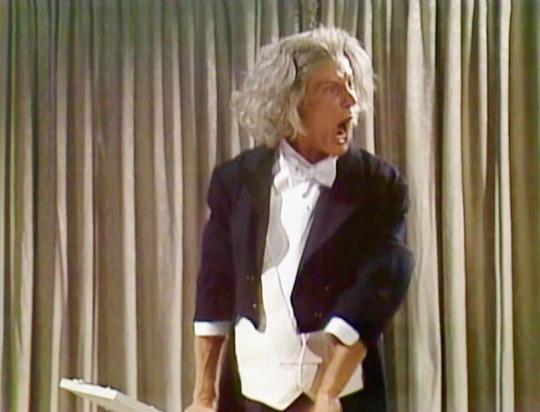
Dick plays a long-haired Maestro (in sneakers) but instead of an orchestra, he conducts dancers. When the dancers go from classical to modern, the Maestro nearly gives up trying to control them, but when the music turns to a Broadway sound, even he joins in.
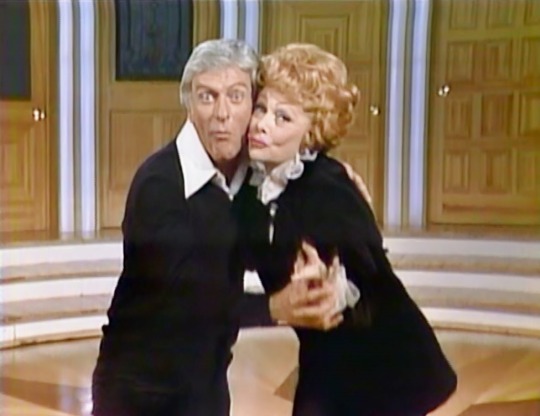
In the closing, Dick sings “You Make It So Easy” to Lucy. The two do some simple, yet funny, dance steps as well.
This Date in Lucy History – December 9

"Lucy and the Military Academy" (TLS S2;E10) – December 9, 1963

"Guess Who Owes Lucy $23.50" (HL S1;E11) – December 9, 1968

“An All-Star Party for Lucille Ball” - December 9, 1984
#Van Dyke & Company#Dick Van Dyke#Lucille Ball#Variety Show#NBC#1976#The Lockers#John Moffitt#Andy Kaufman#Barry Van Dyke#John Wheeler#L.A. Mime Company#Judy Von Wormer#Stu Nahan#TV
9 notes
·
View notes
Text
Little Richard, Trailblazing Rock ‘n’ Roll Pioneer, Dead At 87: Reports
LOS ANGELES (CBSLA/AP) — Little Richard, the trailblazing rock ‘n’ roll pioneer, has died at the age of 87, his pastor confirmed to the Associated Press.
Born as Richard Wayne Penniman, Little Richie died Saturday morning of unknown causes, according to pastor Bill Minson, who was a good friend of his. Rolling Stone was the first publication to report on his death, citing confirmation from his son, Danny Penniman.
Musicians and celebrities alike took to social media following news of his death to pay their respects:
A couple weeks ago I randomly decided to read up on the legendary Little Richard on wiki. I learned then about how he developed The Beatles and saved The Rolling Stones pic.twitter.com/lUEvYG1Mew
— Chance The Rapper (@chancetherapper) May 9, 2020
Rest In Peace To One Of The True Creators Of Rock And Roll. This Is The Commercial I Directed With Little Richard And Michael Jordan, 1991. pic.twitter.com/51bEV1eYKB
— Spike Lee (@SpikeLeeJoint) May 9, 2020
Let’s get the facts straight rock and roll & pop music would not be what it is today without Chuck Berry & Little Richard May he Rest In Peace one of the best performers of all time
The influencer of James Brown, Prince & MJ & Ric Wilson. pic.twitter.com/Ua9zUXHhU6
— disco ric (@RicWilson) May 9, 2020
Sadly, Little Richard passed away today. A founding Father of Rock And Roll, his contributions simply can’t be overstated. I had the honor of meeting Richard in his later years and was awed by his presence. He told me, “I am the architect of Rock And Roll.” Amen! ..Rest In Peace. https://t.co/ceQuNU6pkF
— Gene Simmons (@genesimmons) May 9, 2020
God bless little Richard one of my all-time musical heroes. Peace and love to all his family.








pic.twitter.com/H2lzKbX3tm
— #RingoStarr (@ringostarrmusic) May 9, 2020
Little Richard was one of rock ‘n’ roll’s founding fathers who helped shatter the color line on the music charts, joining Chuck Berry and Fats Domino in bringing what was once called “race music” into the mainstream. Richard’s hyperkinetic piano playing, coupled with his howling vocals and hairdo, made him an implausible sensation — a gay, black man celebrated across America during the buttoned-down Eisenhower era.
He sold more than 30 million records worldwide, and his influence on other musicians was equally staggering, from the Beatles and Otis Redding to Creedence Clearwater Revival and David Bowie. In his personal life, he wavered between raunch and religion, alternately embracing the Good Book and outrageous behavior.
“Little Richard? That’s rock ‘n’ roll,” Neil Young, who heard Richard’s riffs on the radio in Canada, told biographer Jimmy McDonough. “Little Richard was great on every record.”
It was 1956 when his classic “Tutti Frutti” landed like a hand grenade in the Top 40, exploding from radios and off turntables across the country. It was highlighted by Richard’s memorable call of “wop-bop-a-loo-bop-a-lop-bam-boom.”
A string of hits followed, providing the foundation of rock music: “Lucille,” “Keep A Knockin’,” “Long Tall Sally,” “Good Golly Miss Molly.” More than 40 years after the latter charted, Bruce Springsteen was still performing “Good Golly Miss Molly” live.
The Beatles’ Paul McCartney imitated Richard’s signature yelps — perhaps most notably in the “Wooooo!” from the hit “She Loves You.” Ex-bandmate John Lennon covered Richard’s “Rip It Up” and “Ready Teddy” on the 1975 “Rock and Roll” album.
When the Rock and Roll Hall of Fame opened in 1986, he was among the charter members with Elvis Presley, Berry, Buddy Holly, Jerry Lee Lewis, Sam Cooke and others.
Few were quicker to acknowledge Little Richard’s seminal role than Richard himself. The flamboyant singer claimed he paved the way for Elvis, provided Mick Jagger with his stage moves and conducted vocal lessons for McCartney.
“I am the architect of rock ‘n’ roll!” Little Richard crowed at the 1988 Grammy Awards as the crowd rose in a standing ovation. “I am the originator!”
Richard Wayne Penniman was born in Macon, Georgia, during the Great Depression, one of 12 children. He was ostracized because he was effeminate and suffered a small deformity: his right leg was shorter than his left.
The family was religious, and Richard sang in local churches with a group called the Tiny Tots. The tug-of-war between his upbringing and rock ‘n’ roll excess tormented Penniman throughout his career.
Penniman was performing with bands by the age of 14, but there were problems at home over his sexual orientation. His father beat the boy and derided him as “half a son.”
Richard left home to join a minstrel show run by a man known as Sugarloaf Sam, occasionally appearing in drag.
In late 1955, Little Richard recorded the bawdy “Tutti Frutti,” with lyrics that were sanitized by a New Orleans songwriter. It went on to sell 1 million records over the next year.
When Little Richard’s hit was banned by many white-owned radio stations, white performers like Pat Boone and Elvis Presley did cover versions that topped the charts.
Little Richard went Hollywood with an appearance in “Don’t Knock the Rock.” But his wild lifestyle remained at odds with his faith, and a conflicted Richard quit the business in 1957 to enroll in a theological school and get married.
Richard remained on the charts when his label released previously recorded material. And he recorded a gospel record, returning to his roots.
A 1962 arrest for a sexual encounter with a man in a bus station restroom led to his divorce and return to performing.
He mounted three tours of England between 1962 and 1964, with the Beatles and the Rolling Stones serving as opening acts. Back in the States, he put together a band that included guitarist Jimi Hendrix — and later fired Hendrix when he was late for a bus.
In 1968, Richard hit Las Vegas and relaunched his career. Within two years, he had another hit single and made the cover of Rolling Stone.
By the mid-1970s, Richard was battling a $1,000-a-day cocaine problem and once again abandoned his musical career. He returned to religion, selling Bibles and renouncing homosexuality. For more than a decade, he vanished.
“If God can save an old homosexual like me, he can save anybody,” Richard said.
But he returned, in 1986, in spectacular fashion. Little Richard was inducted into the Rock and Roll Hall of Fame, and appeared in the movie “Down and Out in Beverly Hills.”
A Little Richard song from the soundtrack, “Great Gosh A’Mighty,” even put him back on the charts for the first time in more than 15 years. Little Richard was back to stay, enjoying another dose of celebrity that he fully embraced.
Macon, Georgia, named a street after its favorite son. And Little Richard was given a star on the Hollywood Walk of Fame. In August 2002, he announced his retirement from live performing. But he continued to appear frequently on television, including a humorous appearance on a 2006 commercial for GEICO insurance.
Richard had hip surgery in November 2009 at Vanderbilt University Medical Center in Nashville, and asked fans at the time to pray for him. He lived in the Nashville area at the time.
(© Copyright 2020 CBS Broadcasting Inc. All Rights Reserved. The Associated Press contributed to this report.)
0 notes
Photo

bases made by https://xxxstrawberry13xxx.deviantart.com/art/Requested-base-15-164963161 and https://thedeavilbases.deviantart.com/art/Base-11-294846003
more information about the characters under "keep reading".
Lavinia Hamato: The oldest cousin in the Hamato family. She had her Dad's smarts, sarcasm, and awkwardness when it comes to talking to cute guys. She also has her mother's stubbornness, determination and psychic powers which both parents teach her how to use and control. She loves learning ninjustu, reading, and helping her dad with his inventions in the family barn at the farm house where she grew up. She acts like a big sister to her younger cousins and takes her role as team leader very seriously in order to keep her family safe.
Fun facts: -She has 3 fingers and 5 toes.
-she doesn't have much of a shell, just tougher and darker skin on her back and chest.
-Lavi got her nickname from her youngest cousin Yoshi who couldn't say "Lavinia" properly as a toddler.
Sandro Hamato: The second oldest cousin in the Hamato family. A great warrior like both of his parents, he has a bit of an attitude like his Dad, but thankfully not a s bad or else the world would end, at least that's how Mikey puts it. Growing up in the Mutanimal's hideout, it was like he had a few extra uncles that spoiled him rotten. Especially Slash who has a huge soft spot for Raph's kid. Along with his Ninja weapon, Sandro carries around a Salamandrian blaster, a gift from his mom.
Fun facts: -Sandro secretly loves drawing, the only one who knows about this is Slash who gets him art supplies.
-Sandro hates it when people call him Sandy, Angel is the only one who can get away with it.
-Chompy, who was about the size of a dog when Sandro was a kid, is very protective of him and use to sleep next to baby Sandro's crib at night.
Miwa Hamato: The second youngest cousin in the Hamato family, when meeting her, people describe her as emo and unsocial, which is kinda true when it comes to people outside of her family. She's a bit of a daddy's girl, meditating with Leo and watching Space Heroes with him as a little girl. Her mom on the other hand shows a bit more tough love, making sure her daughter is ready for the real world. Miwa understands why her mom can be a little hard on her because of the stories her family tells of their past and of the Shredder. She takes her ninjutsu training very seriously as a result and Is the best archer in the family.
Fun facts: -She grew up with her cousin Yoshi in the Lair so she shows her soft side to him the most.
-She has 5 fingers and 3 toes
-She and Sandro are the only ones with shells, but hers travels down her tail like skin armor, and she has thick skin armor on her head, as a result from Karai's snake mutation.
Yoshi Hamato: The youngest cousin in the Hamato family, despite having his grandfather's name he's a bit more wild then Splinter was. Growing up with a mom from the future, Yoshi and his Papa live in the Lair with his Aunt, Uncle, and cousin. He's as hyper and energetic as Mikey, but he's also a bit more sensitive. He enjoys annoying Miwa when he gets the chance and helping his Papa prank his family and friends. He also shares Mikey's, interesting, taste in unique pizza toppings.
Fun facts: -Growing up Yoshi loved reading Captain Underpants and watching the movie, which Miwa hates with a burning passion.
- He looks up to Miwa like a big sister since they grew up together.
- He and Lavi are the only two that look the most human so they got to go to the surface and off the farmhouse property more often as kids.
Angel: Originally a friend of Lavi, she knew her for a little over a year before she found out about the family secret. Thinking that her friend's lack of fingers and green tinted skin was a medical condition, she fainted when she followed Lavi home one day and met her friend's father, then punched him in the face when she woke up and saw him checking her pulse. Once things calmed down she became very accepting and thought that it was the coolest thing that her friend was a mutant ninja. She lives with her grandma just outside of New York, but likes to hang out in the city when she gets the chance. She and Sandro are very competitive with each other as well.
Fun fact: -Angel is originally from the 2003 ninja turtles show, first time appearing in the episode Fallen Angel.
Daniel Pennington: the son of April's boss at the news station, Danny heard old stories about aliens invading New York before he was born and strange people like animals running around. Finding these stories interesting, Danny did research on the stories to learn more. Which got him into trouble with the Purple Dragons when they found out he was asking around about the Turtles. In the end though it's how he met Lavi and her cousins when they went to save him as an, unofficial, first mission. Ever since then he became close friends with the Hamato family and writes down what he learns about them, leaving his research with the family so his Dad doesn't find it. He's actually the reason the Turtles go down in history later in the future.
Fun fact: -Daniel is originally from the 1990 tmnt live action movie.
Sydney (Quarry): A mysterious child with no memory of her past. After LITTERALLY running into Yoshi in the sewers, and giving him a bloody nose, Leo and the family took her in with open arms and let her live in the Lair with them. With no memory of who she is or what her name is, she was given the name Quarry by Yoshi. Over time she becomes very attached and protective of her first friend. She "pulls a Leatherhead" when cornered in a fight, going completely berserk until Yoshi or the others can calm her down. Despite this she's actually really shy and sticks close to Yoshi when experiencing something new.
Fun fact: -Sydney is originally from the 2003 tmnt show, first time appearing in the episode Notes From the Underground part 1
Wayne Jones: Son of the famous Hockey player Casey Jones, Wayne didn't meet the turtles until he was 12 when he and his dad moved back to New York. Growing up he thought his dad was making up those stories about him and 4 mutant turtles saving the world, until they went to the farm house so Casey could catch up with his childhood friends. Ever since then Wayne has been training in ninjutsu with the Turtles' children, since it's the one athletic thing he can do without the media making a big deal about it and cameras watching him. As they get older Wayne likes to flirt with Miwa, mostly to get a reaction out of her, but over time he starts to actually get a crush on her. He, and Yoshi enjoy pulling pranks together.
Fun fact: - He actually likes baseball more the hockey but there's no way he's telling his dad that.
6 notes
·
View notes
Text
Dwayne Douglas Johnson (The Rock) Journey
Dwayne Douglas Johnson was born on May the 2nd 1972 in Hayward County California. His mother Atta was of samoan origin while his father Wade was a black Nova Scotian Wade. Earned a living as a professional wrestler under the name of rocky Johnson to further entrench the wrestling gene in his blood Dwayne's maternal grandfather also had been a professional wrestler promoted as high chief Peter Maivia. He was the first Samoan wrestler to break into the big-time a generation later rocky became the first black champion to conquer the state wrestling scene. Rocky hustled as a wrestler taking on bouts wherever he could in order to support his family times were tough. With the family moving from state to state in order to keep pace with the wrestling venues in fact during Dwayne's formative years the family of three lived in 38 of the 50 states as they became entrenched in the Gipsy wrestling lifestyle the only time Dwayne got to see his dad was when he went on the road with him.
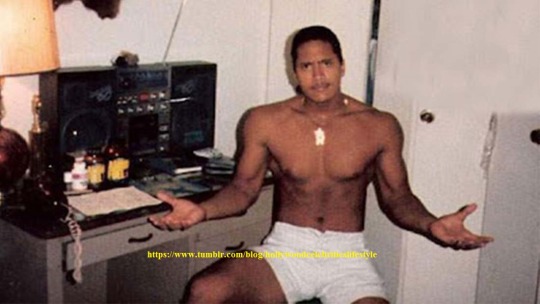
He cherished these times and quickly fell in love with everything to do with professional wrestling. His dad taught him some basic moves including the sleeper hold when he was 11. Dwayne was playing wrestling one school lunchtime when he put the sleeper hold on a classmate the kid immediately passed out unfortunately rocky hadn't shown his son how to bring someone out of the sleeper hold the ambulance and the police were called and rocky had to come down to revive the students. The Johnson house became a hangout for Dwayne's schoolmates who knew that they were going to have to do several round with their host. Dwayne would turn these events into mock TV shows where he would pretend to interview the Restless. He would even interview himself as he portrayed the bad guy his chairmanship was immediately evidence as he came out with all sorts of outrageous pronouncements against his intended victims Dwayne excelled in a number of sports physically.

He was miles ahead of his classmates he had his first weight workouts when he was 13 but he'd been tagging along with his dad to the gym since he was 5 years old as he sat quietly on a bench and watched proudly as rocky pounded out set after set with gargantuan weights Dwayne breathed in the gym atmosphere and marveled at the sight of huge men doing seemingly impossible things with massive loads of iron while other dance took their kids to the playground. Rocky took Dwayne to most of the hardcore gyms in the country it was here that the future superstar learns that there was no replacement for pure gut-wrenching hard work at the age of 8 rocky allowed Dwayne to participate in sports. He tried baseball soccer martial arts and gymnastics what he really longed to do was lift weights but it'd have to wait a few more years to get into that. Finally on his 13th birthday his dad took him to a local gym for his first ever weights workout an obvious place to start was the bench press which had studied for years as his dad and others pressed massive amounts of Steel from their chests rocky had his son start with an unloaded bar he pumped out 10 reps with no problem so rocky added a 20 pounds plate to each ends this time Dwayne pushed out eight easy reps impressed.
Rocky asked his son if he wanted to try the 45 pounders Dwayne not at his head his dad stood behind him and lifted the bar off the supports and Dwayne got buried under the 135 pound weight he felt embarrassed and ashamed as if he had let his dad down that feeling fueled an intense desire to get better at the benchpress and within a few years he would be benching 400 pounds between the ages of 14 and 15. Dwayne excelled in the gym by the time you entered high school he had grown to a towering 6-foot 3-inches and tipped the scale at 225 pounds his imposing physicality gave him a great steel of self-confidence which sometimes bordered on arrogance but his unstable home life that saw his father constantly traveling left him directionless. When he wasn't pounding the weights as a result of this he started to get into trouble it came to a head when he was 15 and he got arrested for check fraud.

His parents had to come and collect him from the police station when he looked at his mother and father and he realized that despite living from paycheck to paycheck he was the biggest source of stress in their lives. In that moment he vowed that he would never cause problem for his parents again although that was the last time that Dewayne got arrested it wasn't the last time he caused worry for rocky Anita in fact that very next day at school he got into a fight and knocked the other kid out it turns in a two-week suspension. Upon returning to school he decided that the students bathroom was not good enough for him and so he decided to use the teachers one when asked to leave he was rude to the teacher and tried to intimidate him with his physical presence that night drain felt pangs of guilt of the way he had treated the teacher so the next day he marched in to the teachers class and holding out his hand said that he wanted to apologize for the way he had acted the day before the teacher stared at Duane's hand for a moment and then grabs it and told Wayne that he appreciated the apology then still holding the boy's hand he said I want you to play football for me. football proved to be a positive outlet for Dwayne's frustrations and aggressions providing him with a renewed sense of focus under the watchful eye of coach. being Twain's workout intensity and dedication have been an inspiration to millions. He hits the gym at 4:00 a.m. every morning training for up to two hours with heavy basic compound moves in dispersed with cardio to keep his body fat percentage into the single digits.
He is also a favorite in the bodybuilding community appearing as a guest host at the 2016 mr. Olympia competition since 2014. Dwayne has been living in Southwest Ranches in Florida his first child Simone was born in 2001 while he was still married to her mother Danny in 2015 his second daughter Jasmine was born to his girlfriend of nine years Lauren hash Ian. Dwayne Johnson has risen from humble beginnings to establish himself as the most bankable movie star of the 21st century in the process he has brought back to mainstream entertainment the sort of alpha male persona that has been so absent for so long. He has become the people's champion once again.
For more details check this video
youtube
#recent photos of the rock#the rock photo gallery#wwe rock images hd#rock gym workout photos#dwayne the rock johnson hd wallpapers#dwayne johnson images#dwayne johnson wallpapers mobile#the rock wallpaper iphone
0 notes
Text
BOB HOPE’S WORLD OF COMEDY
October 30, 1976

Produced and Directed by Jack Haley Jr.
Written by: Charles Lee with Gig Henry, Jeffrey Barron, Katherine Green, and Jack Haley Jr.
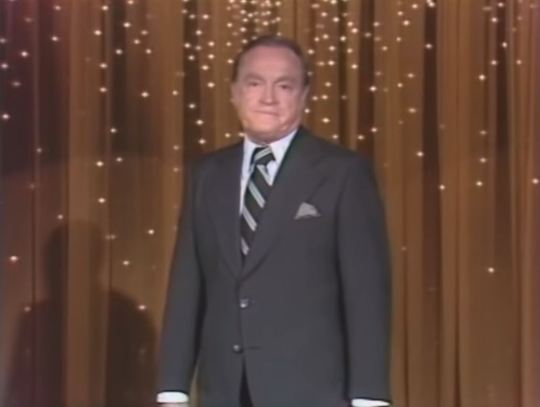
Bob Hope (Himself, Host) was born Lesley Townes Hope in England in 1903. During his extensive career in virtually all forms of media he received five honorary Academy Awards. In 1945 Desi Arnaz was the orchestra leader on Bob Hope’s radio show. Ball and Hope did four films together. He appeared as himself on the season 6 opener of “I Love Lucy.” He did a brief cameo in a 1964 episode of “The Lucy Show.” When Lucille Ball moved to NBC in 1980, Hope appeared on her welcome special. He died in 2003 at age 100.

Lucille Ball (Herself) was born on August 6, 1911 in Jamestown, New York. She began her screen career in 1933 and was known in Hollywood as ‘Queen of the B’s’ due to her many appearances in ‘B’ movies. With Richard Denning, she starred in a radio program titled “My Favorite Husband” which eventually led to the creation of “I Love Lucy,” a television situation comedy in which she co-starred with her real-life husband, Latin bandleader Desi Arnaz. The program was phenomenally successful, allowing the couple to purchase what was once RKO Studios, re-naming it Desilu. When the show ended in 1960 (in an hour-long format known as “The Lucy-Desi Comedy Hour”) so did Lucy and Desi’s marriage. In 1962, hoping to keep Desilu financially solvent, Lucy returned to the sitcom format with “The Lucy Show,” which lasted six seasons. She followed that with a similar sitcom “Here’s Lucy” co-starring with her real-life children, Lucie and Desi Jr., as well as Gale Gordon, who had joined the cast of “The Lucy Show” during season two. Before her death in April 1989, Lucy made one more attempt at a sitcom with “Life With Lucy,” also with Gordon, which was not a success and was canceled after just 13 episodes.
Neil Simon (Himself) is a playwright and screenwriter responsible for more than 30 plays, most of which were seen on Broadway and adapted into films. At the time, one of his most enduring plays The Odd Couple was being done on television. In 1983 became the only living playwright to have a New York theatre named in his honor. In 1960, when it was still called the Alvin Theatre, Lucille Ball appeared there in the musical Wildcat.
Don Rickles (Himself) worked as a stand-up comic in nightclubs for nearly 20 years before making his film debut in 1958. Rickles was known as an insult comic and became a staple of Hollywood roasts. In “Lucy the Fight Manager” (TLS S5;E20) he made his first and last acting appearance with Lucille Ball, but would be seen with her on variety shows and specials through 1988. Rickles was the voice of Mr. Potato Head in the animated Toy Story franchise. He died in April 2017 at age 90.
Norman Lear (Himself) is a television writer and producer responsible for such hits as “All in the Family,” “Maude,” “One Day at a Time,” “The Jeffersons,” and many others. He received three Emmy Awards for his work on “All in the Family.”
Caroll Spinney (Big Bird) started playing Big Bird on “Sesame Street” in 1969. In 2000, Big Bird was named a Living Legend by the United States Library of Congress. Created by Jim Henson, Big Bird is one of two Muppets to have a star on the Hollywood Walk of Fame. Spinney has been honored with four Daytime Emmy Awards for his portrayals on the series and two Grammy Awards for his related recordings. Two recordings of Spinney's voice have earned Gold Record status.

As with many Bob Hope specials, the show is sponsored by Texaco.
Bob Hope's opening monologue talks mainly about the Presidential Election, which would take place in two weeks. Incumbent president Gerald Ford ran against Jimmy Carter. He also touches on the World Series, the Swine Flu epidemic, Zsa Zsa Gabor's multiple marriages, and the CB radio craze.
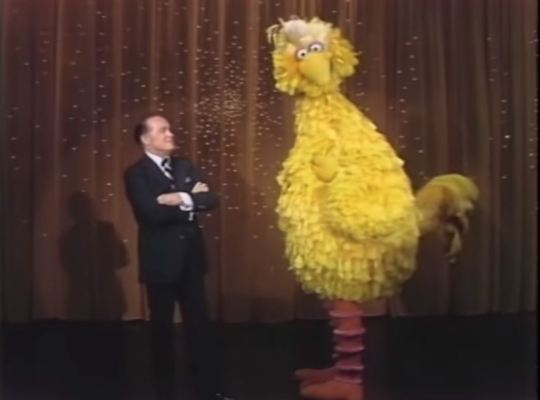
Bob's first guest is Big Bird from “Sesame Street” (Caroll Spinney). Big Bird does an ad-lib impersonation of Jack Benny that makes Hope laugh. This kicks off a montage of clips about animals.
A pet shop staffed by Bob Newhart
Jackie Gleason playing golf with Mildred, a chimp in How To Commit Marriage (1969)
Roy Rogers and Trigger “the wonder horse”
Julie London with puppies who prove not to be housebroken
Dan Rowan with a horse and Dick Martin with a camel
Hope with his dog in a vet's waiting room and Betty Grable there with a race horse
Hope and Greer Garson in divorce court fighting over their dog, Mr. Smith
Lassie as the subject of “This is Your Life” in a spoof from “The Bob Hope Show”
Next Hope introduces a montage of clips featuring international stars.
Maurice Chevalier (France)
Eva Gabor (Hungary)
Zsa Zsa Gabor (Hungary) with Angie Dickinson
Ingrid Bergman (Sweden)
Anita Ekberg (Sweden) with William Holden and Robert Strauss
Olivia Newton John (Australia)
Rex Harrison (England) and Lilli Palmer (Poland) with Janis Paige
David Niven (England) with Marilyn Maxwell

After a Texaco commercial, Bob introduces Lucy Ricardo aka Lucy Carmichael aka “the bionic woman of comedy” - Lucille Ball.

Lucy reminisces with Bob, which leads to a black and white clip of a sketch from “The Bob Hope Show” (September 24, 1962). In it, Lucy plays a District Attorney and Bob a gangster named Bugsy Hope.

Back on stage, Bob asks Lucy the secret to her show's endearing success. She says that it has to do with the realatable domestic situations created by the writers. Bob add that the physical comedy gives her comedy world-wide appeal. Lucy says that as of last count her shows were seen in 79 countries. Lucy says she's heard herself dubbed in Japanese, and that in South America it is HER who as the accent. Asked about being a legend, Lucy says it is “kind of like an obituary” but she's very grateful.
After another Texaco break, Bob talks about slapstick and introduces a montage of clips.
Ernie Kovacs trying to sell his house during an earthquake
Bob as Bobby Riggs playing against Billie Jean King (Ann-Margret)
Hope and Douglas Fairbanks Jr. as astronauts walking in space
Jack Benny using hidden cameras in his home to avoid paying Hope a guest-star fee

The second hour of the special kicks off with Hope introducing playwright Neil Simon. They talk about writing, the difference between drama and comedy, and ethnic humor, which is the cue for the next montage of clips about vaudeville.
Hope and Crosby do a routine
Hope, Crosby, Steve Allen, and Jack Paar are child actors competing for the same job
Danny Thomas as a candy seller interrupting Hope's act by stealing all his punchlines
Donald O'Connor as Wingo the Magnificent, a knife thrower, with Hope as Courageous Targo, his human target

Hope introduces Don Rickles, who promotes his new show “CPO Sharkey” which he compares to Phil Silvers in “Sergeant Bilko.” Hope says he's been the victim of insult comedy, which begins a montage of clips where Bob is insulted by:
Milton Berle
Tony Randall
Redd Foxx
Glenn Campbell
Gina Lollobridgida
Jerry Colonna
Dorothy Lamour
Tony Bennett
Fred MacMurray
Joan Crawford
George Sanders
Frank Sinatra
Troy Donahue
Hedda Hopper
John Wayne
Dyan Cannon
Debbie Reynolds (with Jack Benny)
Juliet Prowse

Bob Hope introduces Norman Lear, who mentions he has no shows on NBC. They talk about “Mary Hartman Mary Hartman,” the 'Family Hour,' his flops like “Hot L Baltimore,” and Archie Bunker. The next batch of clips is about satire.
Johnny Carson as a playboy movie star Rock Carson appearing on a talk show
Hope, Burt Reynolds and Dyan Canon spoof the TV series “Paper Moon”
A sketch called “Bananaz” (“Bonanza”) starring Bing Crosby, Bob Hope, and Juliet Prowse
A “Batman” spoof starring Martha Rae as Bat Girl and Bob Hope as the villain Lobsterman
Medical dramas are poked fun at by Hope, Barbara Eden, and Lee Marvin

After a commercial, the montages are about dancing. Some of Hope's choreographed clips:
Dancing with Raquel Welch
Doing Eddie Foy's famous sand dance
Soft shoe with Pearl Bailey
A trio with Jeanne Crain and Betty Hutton
A challenge dance with George Burns
Rare footage of Dean Martin dancing alongside Hope
Polly Bergen, Jimmy Durante and Hope dance as babies while on their knees (above photo)
A partner dance with Ginger Rogers
Hoofing with Hope and Jimmy Cagney
Modern dance with Ann-Margret
Hat and cane steps with Sammy Davis Jr.
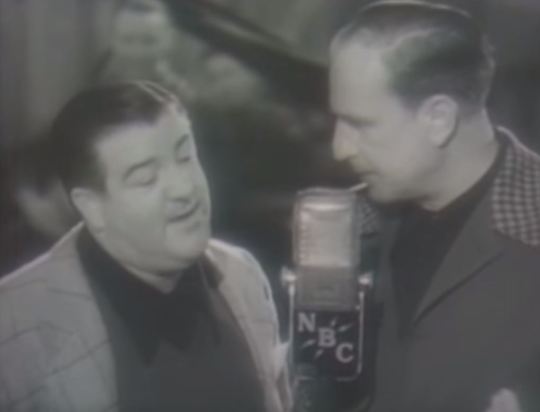
Hope wraps up the special with a look at some of the comedians of the past.
Budd Abbott and Lou Costello (above photo)
Fred Allen
Gracie Allen
Cliff Arquette aka Charlie Weaver
Mischa Auer
Robert Benchley
Jack Benny
Willy Best
Fanny Brice, the original 'Funny Girl'
Joe E. Brown
Billy Burke
Eddie Cantor
Jack Carson
Charles Correll, Amos of “Amos 'n' Andy”
Wally Cox
Joan Davis
Marie Dressler
Leon Errol
W.C. Fields
Billy Gilbert, the greatest sneeze in show business
Ted Healy and the Three Stooges
Hugh Herbert
Judy Holliday
Edward Everett Horton
Buster Keaton
Edgar 'Slow Burn' Kennedy
Ernie Kovacs
Burt Lahr
Stan Laurel and Oliver Hardy
Harold Lloyd
Carol Lombard
Harpo and Chico Marx
Donald Meek
Victor Moore
Jack Norton, the perennial drunk
Franklin Pangborn
Joe Penner
Will Rodgers
Irene Ryan, Granny of “The Beverly Hillbillies”
Charlie Ruggles
S.Z. 'Cuddles' Sakall
Max Sennett, king of the Keystone Cops
Arthur Treacher
Burt Wheeler and Robert Wolsey
Ed Wynn
This Day in Lucy History – October 29th
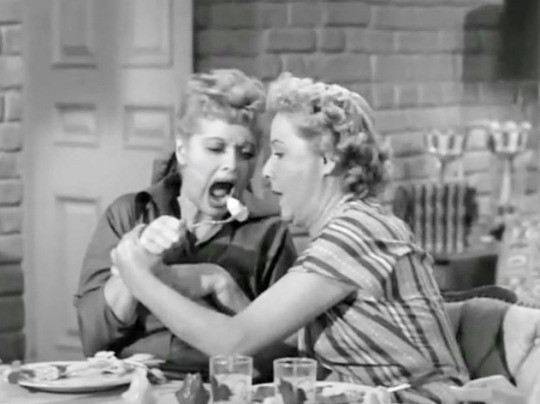
“The Diet” (ILL S1;E3) – October 29, 1951

"Visitor from Italy" (ILL S6;E5) – October 29, 1956
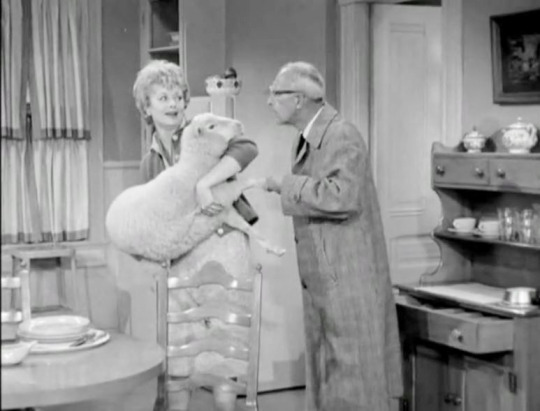
"Lucy Buys a Sheep" (TLS S1;E5) – October 29, 1961
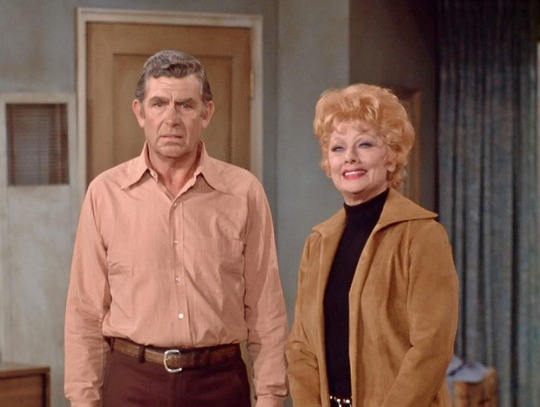
"Lucy and Andy Griffith" (HL S6;E8) – October 29, 1973
#Bob Hope's World of Comedy#Bob Hope#Lucille Ball#Neil Simon#Norman Lear#BIg Bird#Caroll Spinney#1976#TV#NBC#Jack Haley Jr.#Don Rickles#Texaco
0 notes
Text
LUCY THE FIXER
S1;E14 ~ January 6, 1969
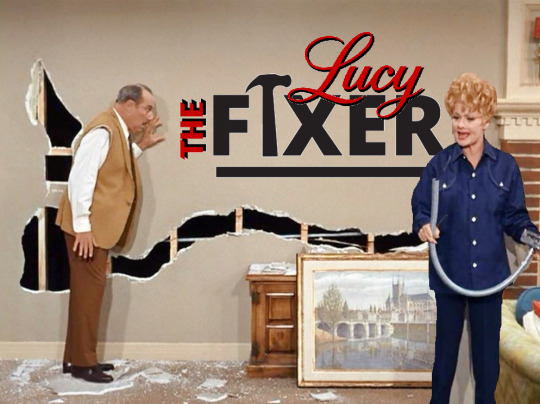

Directed by Jack Donohue ~ Written by Milt Josefsberg and Ray Singer
Synopsis
When Lucy called to Harry's house to take dictation, she tries to fix a broken lamp. In the process she succeeds in nearly wrecking Harry's home!
Regular Cast
Lucille Ball (Lucy Carter), Gale Gordon (Harrison Otis Carter), Lucie Arnaz (Kim Carter), Desi Arnaz Jr. (Craig Carter)

This is the first episode of 1969. It is one of the few to feature just the principal cast members. It is the only one to only include the entire Carter Family!
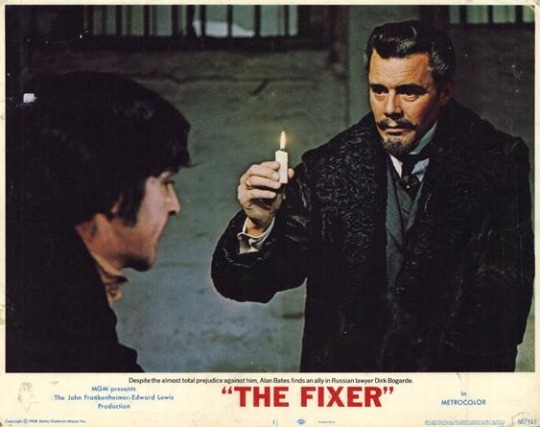
Coincidentally, the title is the same as the 1968 film The Fixer, which would soon be nominated for Golden Globes and Oscars. The plots, however, have no similarity.
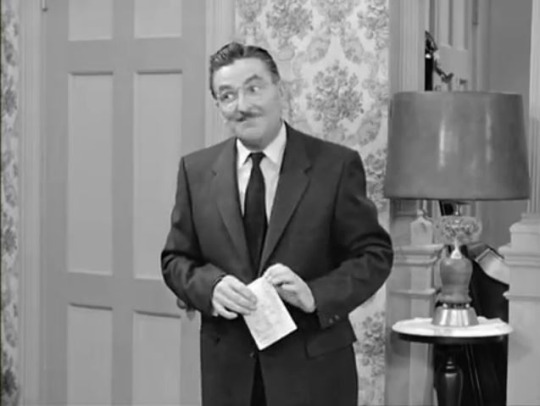
Three days before this episode first aired, Desilu regular Howard McNear died at age 68. He was best known as Floyd the barber on “The Andy Griffith Show” but also appeared with Lucille Ball and Desi Arnaz in The Long, Long Trailer (1954) and as Mr. Crawford, Little Ricky’s music teacher in “Little Ricky Gets Stage Fright” (ILL S6;E4).
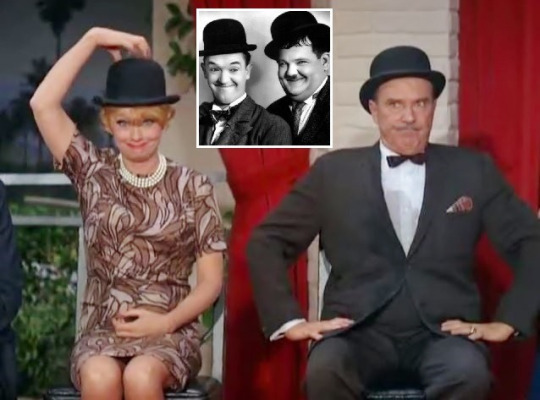
In her introduction to the episode on DVD, Lucie Arnaz compared her mother and Gale Gordon's physical comedy to that of Laurel and Hardy, a comparison that has also been made by others. As Lucy Carmichael and Mr. Mooney, the pair pantomimed being Laurel and Hardy under the spell of Miss Pat, the Hip Hypnotist in “Lucy and Pat Collins” (TLS S5;E11). After Stan Laurel’s death, Lucille Ball appeared on “A Salute to Stan Laurel” which aired on November 23, 1965.
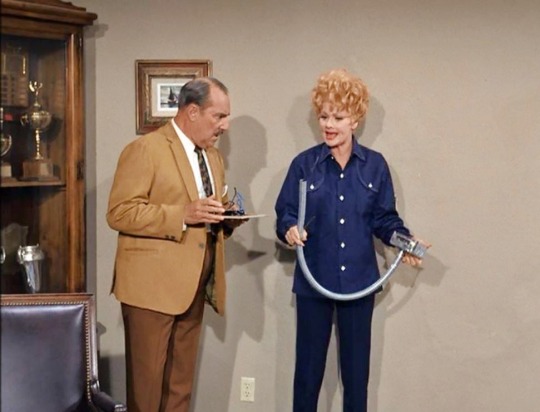
Although Lucille Ball Productions (LBP) may have saved money on actor salaries with this episode, the production costs must have increased substantially as Lucy had to destroy Harry's living room – not once but several times. Lucille Ball was a stickler for rehearsals, so the entire set had to be reconstructed from scratch between rehearsals and filming.
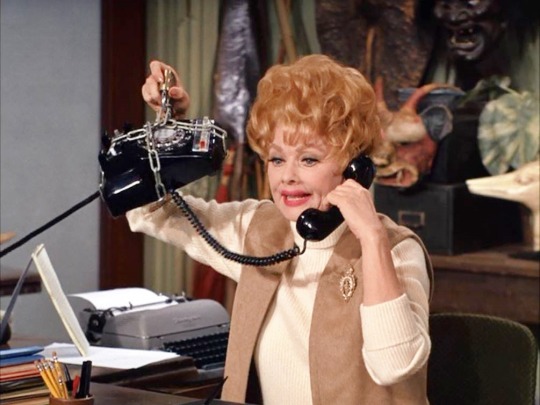
At the office, Lucy gets a call from her friend Isabel - if only for the sake of a visual gag of locking the telephone with a chain and padlock. Two weeks later, Isabel will make her first of two appearances played by Lucille Ball’s old friend Mary Wickes. Although the Isabel disappears, Wickes goes on to create 7 more characters on “Here’s Lucy.”

Thrifty Uncle Harry scolds Lucy for wasting office supplies! He calculates that she has wasted 6 sheets of paper a day, which amounts to 30 sheets a week, 1560 sheets a year, and 15,600 in a decade! This was pre-recycling!
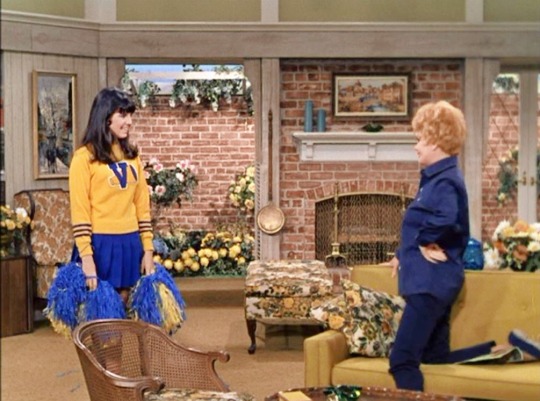
“Rip ‘em with a beat,
Tear ‘em with a paw,
Throw ‘em in the meat grinder
Rah rah rah!”
We discover that Kim is a cheerleader. Lucy says she was also a high school cheerleader and was voted Miss Cheerleader of 193--... Needless to say, the decade is as much as Lucy is willing to share. In real life, had Lucille Ball stayed in high school instead of heading to New York City to seek fame and fortune, the decade would have been the 1920s, not the '30s.
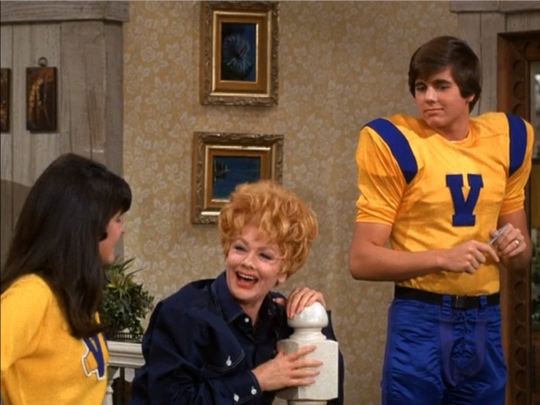
Craig is on the football team – he is a substitute offensive guard on the third team. But he looks good in his uniform! Lucy reminds him that John Wayne started out as an extra. Wayne's first twenty films from 1926 to 1930 were as an uncredited background performer. The eventual Oscar winner was a favorite of Lucille Ball's, appearing as himself on both “I Love Lucy” and “The Lucy Show.” He was mentioned on “Here's Lucy” in “Lucy, the Matchmaker” (S1;E12) and “Lucy and Eva Gabor” (S1;E7).

In a 1972 episode, college student Craig ponders switching from tennis (Desi Jr.’s real-life passion), to football, with some encouragement from guest star Joe Namath. This was the last appearance of Craig Carter.
When Craig says he wants to show his football inform to some friends, Lucy guesses that he means Danny and Steve. Lucie adds Carol and Susie and Doreen and Eileen and Josephine and Betty. Interestingly, she doesn't add Annie, Lori, or Elsie - all female friends of Craig's mentioned (but not seen) in previous episodes. This is likely because the episodes were written by different writers.
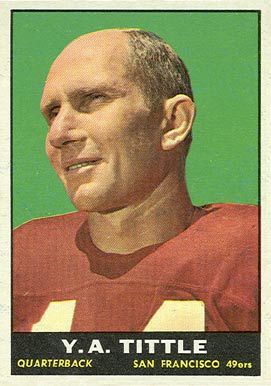
Lucie says her brother is the “Y.A. Tittle of the teenybopper set.” Yelberton Abraham Tittle Jr. (1926-2017), better known as Y.A. Tittle, was a professional football quarterback who played for the San Francisco 49ers, New York Giants, and Baltimore Colts. His final season was in 1964.

This is the first time we visit Harry's home.

The painting of the Paris suburbs that Harry had hanging on the wall is by K. Chin (1920-95). During W.W.II, K Chin served as a mechanical draftsman with the US Air Corps, during this time he honed in on his skill at creating images with great detail. After working in advertising, Chin spent two years with Norcross Greeting Cards.

When Harry loses his patience with Lucy, he threatens her with physical violence! Lucy tells him to take his arm out of the hole in the wall. Harry says that he can’t.

His reply is a tribute to “The Honeymooners” (1955-56) in which bus driver Ralph Kramden frequently said the same thing to his stoic wife, Alice. Coincidentally, the character of Ralph Kramden (Jackie Gleason) appeared in a wordless cameo in the second episode of “Here’s Lucy”!

When Harry finds a kitten behind the wall, Lucy asks it “What's new pussycat?” That was the title of a 1965 film by Woody Allen and an Oscar-nominated song of the same name by Burt Bacharach and Hal David. The song was made famous by Tom Jones and reached #3 on the pop charts.
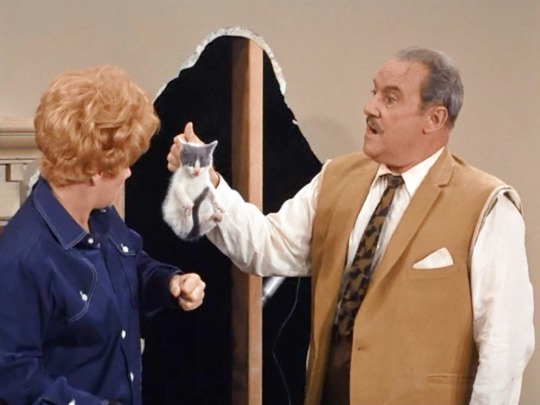
Off the many animals that Lucille Ball has had on her shows, this is the first time she has ever worked with a house cat!

On “Here’s Lucy,” wherever there's water, Gale Gordon will get wet! Kim finds what she thinks are wires, but turn out to be pipes – pointed right at Uncle Harry. This was a running gag on “The Lucy Show” and “Here's Lucy.”
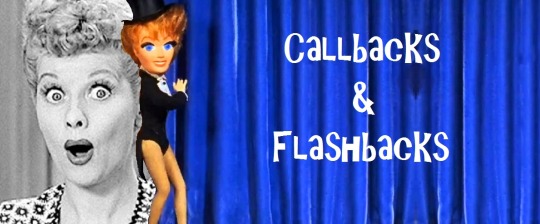
Harry wants to dictate a letter to Rylander Moser and Tibbet. This is the same firm Mr. Mooney (Gale Gordon) often mentioned on “The Lucy Show.”

On “The Lucy Show,” Lucy Carmichael's daughter Chris was a cheerleader and her son Jerry was a football player. Like Lucy Carter, Lucy Carmichael was also a cheerleader in school. Coincidentally, both times her school colors were blue and yellow.
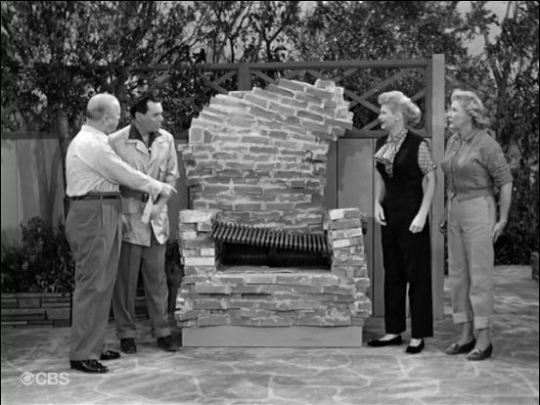
After the carnage to his living room, Harry calls his sister-in-law “Hurricane Lucy.” On “I Love Lucy,” when Lucy and Ethel make a mess of reconstructing their Connecticut barbecue, Ricky guesses that it was caused by “Hurricane Lucy and Hurricane Ethel.” In 1971, a real Hurricane Lucy hit the Philippines.
FAST FORWARD!

A clip from this episode was part of “Lucy and Harry’s Memoirs” (S5;E24), closing up the Unique Employment Agency while slowly getting drunk on champagne. It was intended to be the final episode of the series, until Lucille Ball was convinced to do a sixth season. Like "Lucy the Fixer”, the only characters are the Carter family, although Craig and Kim are only seen in archival footage.
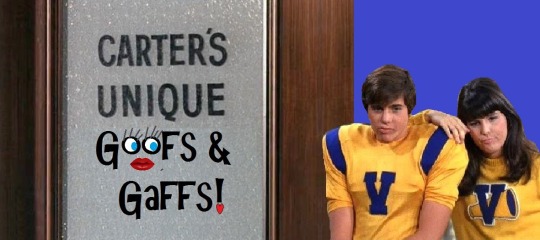
Make-Up! In close-ups of Gale Gordon, viewers can see the stage make-up smudges on his white shirt collar.
Wardrobe! After the commercial break in the destruction scene, Lucy is suddenly wearing blue gloves. Naturally, they perfectly match her outfit!
Sitcom Logic Alert! Harry finds a live kitten living behind his wall. He then simply sets it down outside the living room door saying “go home”! It is never mentioned again! Not only did a kitten survive behind the walls of a home, but it let itself out the front door!

Equipment in Frame! When Kim is looking for the lost wires, the camera pulls back for a wide shot and viewers can see the stage lighting near the top of the frame.
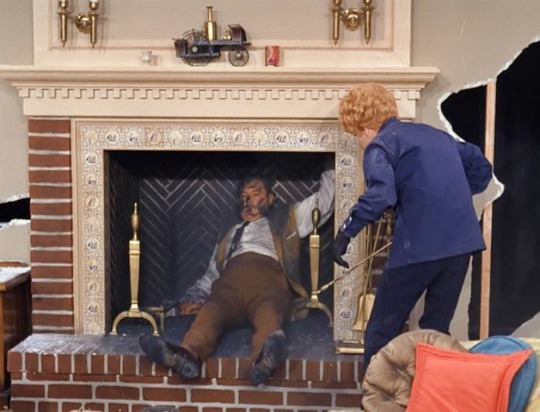
Stunt-Ready Set! To facilitate the stunts, the fireplace has no screen or grate, although the production designers did remember ashes!

“Lucy the Fixer” rates 5 Paper Hearts out of 5
Although the first act drags a bit, the second half is some of the best prop comedy Lucille Ball has done since “I Love Lucy”. It is also a great example of the comic timing of Gale Gordon.

#Here's Lucy#Lucille Ball#Gale Gordon#Lucy the fixer#Lucie Arnaz#Desi Arnaz Jr.#1969#CBS#TV#John Wayne#Laurel and Hardy#What's New Pussycat#Y.A. Tittle#Football#Cheerleader#The Fixer
4 notes
·
View notes
Text
LUCY AND WAYNE NEWTON
S2;E22 ~ February 16, 1970

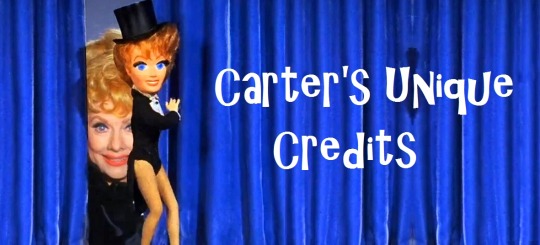
Directed by Danny Dayton ~ Written by Milt Josefsberg and Ray Singer
Synopsis
The Carters go to Las Vegas to see the shows, but Lucy loses all their money in a gas station slot machine. On their way home they discover a stray pony and return him to the owner, who turns out to be singer Wayne Newton. The Carters take jobs as Newton's ranch hands to make enough money to return to Vegas.
Regular Cast
Lucille Ball (Lucy Carter), Gale Gordon (Harrison Otis Carter), Desi Arnaz Jr. (Craig Carter), Lucie Arnaz (Kim Carter)
Guest Cast

Wayne Newton (Himself) previously played himself in “Lucy Sells Craig to Wayne Newton” (S1;E9) and “Lucy Discovers Wayne Newton” (TLS S4;E14). He is one of the best-known entertainers in Las Vegas, known by the nicknames the ‘Midnight Idol,’ ‘Mr. Las Vegas’ and ‘Mr. Entertainment.’ His well-known songs include 1972’s “Daddy, Don’t You Walk So Fast” (#4 on the Billboard chart), “Years” (1980), and his signature song “Danke Schoen” (1963). This is his final episode of “Here’s Lucy.”
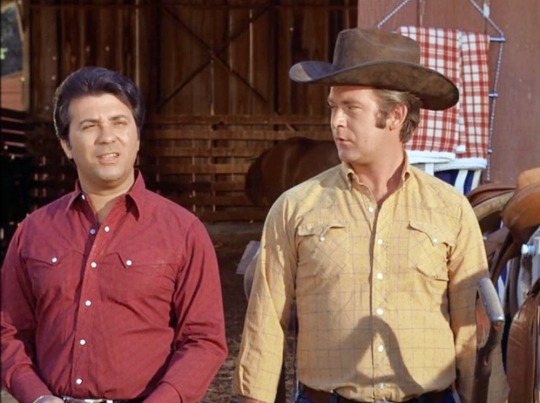
Jerry Newton (Himself, Guitarist, right) is the older brother of Wayne Newton. He also appeared in 1968’s “Lucy Sells Craig to Wayne Newton” (S1;E9).
Jerry’s catch phrase is “Oh, gosh yes.” Although Wayne Newton calls him by his first name, it is never mentioned that the two are brothers.
Tommy Amato (Himself, Bass Player, left) was a bandleader and Wayne Newton’s bass player. He also appeared in 1968’s “Lucy Sells Craig to Wayne Newton” (S1;E9).
Amato is not identified by name in the dialogue.
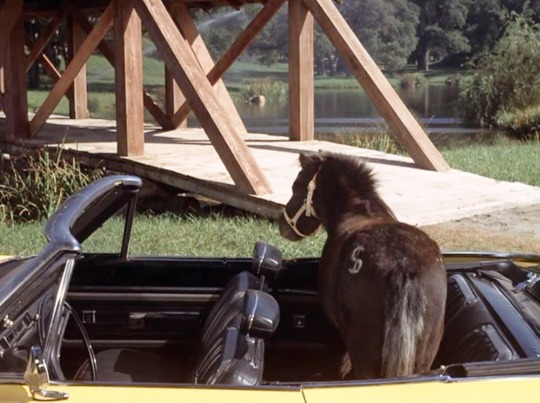
Tiny Tim (T.T.) is an Angolan miniature horse from South America.
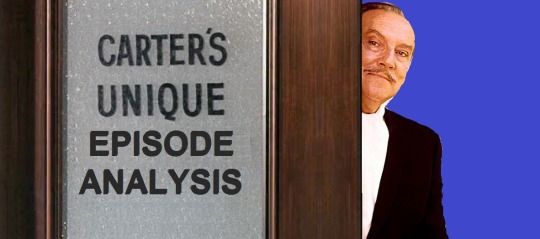
This is the second and last episode for director / actor Danny Dayton, who also was director of “Lucy Protects Her Job” (S2;E14).
The final draft of this script by Josefsberg and Singer was dated October 1, 1969.

Following the original broadcast of this episode, “The Doris Day Show” featured ‘Lucy’ supporting players Bobby Jellison, Mabel Albertson, and Hal Smith.
This episode is filmed on location in the San Fernando Valley. Second unit footage of the Las Vegas Strip featured doubles for the cast. The in-car driving scenes were done using a studio process shot.
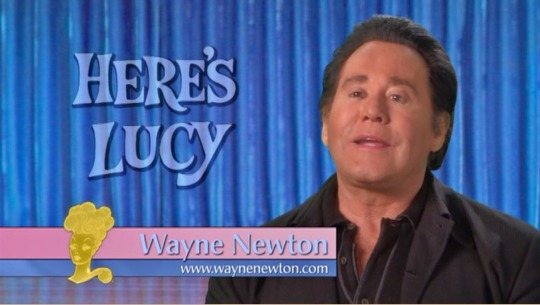
In his introduction to the episode on DVD Wayne Newton recalls that this episode nearly caused a rift between him and Lucy due to the demands of the production.

Musical Director Marl Young takes over the introduction and enthusiastically recalls writing the jazz background music for the montage of the drive down the Las Vegas strip. Young mistakenly calls “Gary Morton” and “Gale Gordon” “Gary Martin” and “Gale Garden.”
Sunset Strip Montage

Caesars Palace – opened in August 1966 and is still operating today. The marquee headliner is Frank Sinatra with Little Richard with the Nitty Gritty Dirt Band.
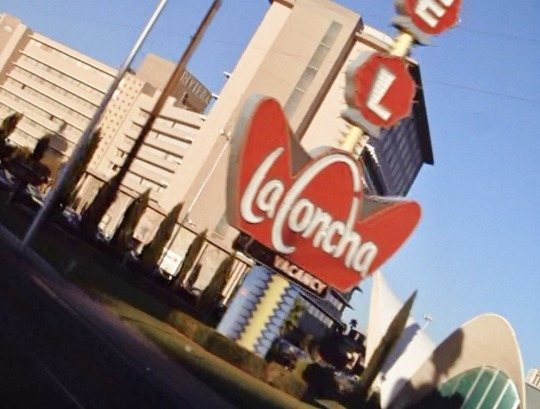
La Concha - was a motel that opened in 1961 and closed in 2004. The sign is restored and preserved in Las Vegas's Neon Museum. It was named after the resort community of La Concha, Spain. It was neighbors with the Riviera, which is in the background.

Stardust – was located at 3000 Las Vegas Boulevard South. It was first opened in 1958 and demolished in 2007. The famed Stardust sign became one of the symbols of Las Vegas. The entertainment roster featured with the spectacular French production show Lido de Paris.

International - opened in 1969 and was known for many years as the Las Vegas Hilton, then briefly as the LVH - Las Vegas Hotel and Casino. It was renamed the Westgate Las Vegas in 2014. Upon opening, the International was the largest hotel in the world. The headliner at the time of the filming of the footage was Bill Cosby with Lionel Hampton. Interestingly, the International boasts the opening of a Children's Youth Hotel!
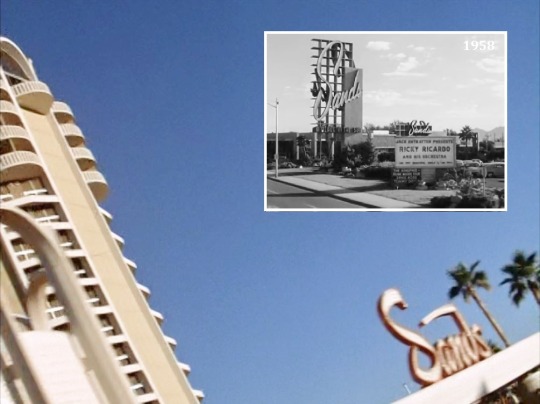
Sands - was a historic hotel and casino on the Las Vegas Strip that operated from 1952 to 1996. The Sands was the seventh resort to open on the Strip. During its heyday, the Sands was the center of entertainment and hosted many famous entertainers of the day, most notably the Rat Pack. The Sands was featured in “Lucy Hunts Uranium” in 1958 (inset).

Flamingo – opened the day after Christmas 1948 and is still operating today. It is located at 3555 South Las Vegas Boulevard. The hotel was the third resort to open on the Strip and remains the oldest resort on the Strip still in operation today. The headliner at the time was comedian Pat Paulsen.

Frontier - was the second resort that opened on the Las Vegas Strip and operated continuously from October 1942 until it closed on July 16, 2007 and was demolished. It has the distinction of hosting Elvis Presley's first Vegas appearance in 1956, and the final performance of Diana Ross and The Supremes on January 14, 1970. At the time of filming singer Abbe Lane and comic Dick Shawn were headlining. Shawn guest starred in “Lucy and the Pool Hustler” (TLS S6;E13) in 1968. At one time, Abbe Lane was married to Xavier Cugat, Desi Arnaz's mentor and Ricky Ricardo's competition.

Thunderbird – was located at 2735 Las Vegas Boulevard South and operated from 1948 to 1992. It was the fourth resort to open on the strip and had a Native American theme that featured a Navajo-based restaurant, the only bowling alley ever on the Strip, and a showroom. The marquee here promotes a stage production of Rodgers and Hammerstein's 1958 Broadway musical Flower Drum Song starring Jack Soo, who had also been in the 1961 film adaptation. Interestingly, the Thunderbird wooed gamblers with the promise of 'Free Nylons with Jackpots'! From 1976 the property was known as the Silverbird and then, finally, El Rancho.

Bonanza – opened in July 1967 on land formerly occupied by Three Coins Hotel and Casino. It was later renamed the New Bonanza Hotel and Casino. In 1973 it became part of Bally's Las Vegas. It is not connected to the Bonanza Gift Shop, a landmark store on the Strip and one of the largest such establishments in the word.

Riviera - operated from April 1955 to May 2015. It was the first high-rise and the ninth resort on the Las Vegas Strip. Liberace cut the opening ribbon, and became the first resident performer. The building was demolished in 2016.
The only sign that is missing from the montage is the iconic “Welcome To Fabulous Las Vegas Nevada” sign that is now visually associated with the gambling town.
Craig notices that Dean Martin is playing at the Riviera. Desi Arnaz Jr. was in a band with Martin's son. Kim says “He's one of my favorites!” Martin guest starred as himself (and his doppelganger) on “The Lucy Show.” His opening act at the Riviera is comedienne Totie Fields, who will act on a 1972 episode of “Here's Lucy.” In 1975, she was one of the comics to roast Lucille Ball on “The Dean Martin Celebrity Roast.”
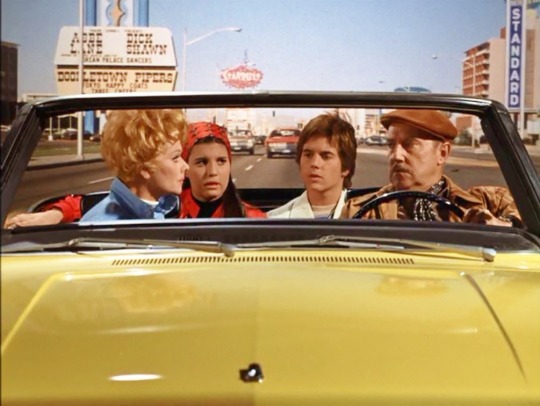
Harry's 1970 yellow Plymouth Satellite convertible was previously seen in “Lucy and Viv Visit Tijuana” (S2;E19).

Also during the driving scene, the background shows a marquee for P'zazz '70, a lavish stage show at the Desert Inn Hotel and Casino, in operation from 1950 to 2000. The show started out as P'zazz '68 and was updated.

Their drive down the Strip also takes them past The Castaways casino, where Cotton Club Revue 70 is playing. The above snapshot was taken in September 1969, around the same time as filming. Castaways operated from 1963 to 1987, when it was imploded to make way for the Mirage. In 1967, the Castaways was sold to billionaire Howard Hughes for $3 million as part of his spree of buying Las Vegas properties. Coincidentally, the reclusive millionaire is also mentioned in this episode.
CRAIG (to Harry): “If you didn’t come to Las Vegas to see shows, what did you come for?”
LUCY: “He came to kiss Howard Hughes’ ring.”

The foursome encounter a miniature horse on the side of the road but don't know exactly what sort of horse it is. Lucy says she can't imagine John Wayne sitting on it; Mickey Rooney, yes. John Wayne appeared on both “I Love Lucy” and “The Lucy Show” while Mickey Rooney starred with Ball in Thousands Cheer (1943) and as an acting teacher on a 1966 episode of “The Lucy Show.”

Wayne Newton purchased the first five acres of what is now Casa de Shenandoah in 1966. It was raw land, with no well or electricity. The first house was built between 1966 and 1968, along with four stalls for a horse barn. He lived in that home with his parents and older brother. He then acquired additional acres between 1969 and 1972. Construction of the Mansion began in 1973 and was completed in 1976. Today, Casa de Shenandoah is one of the top tourist attractions in Las Vegas.

Although the episodes were by different writers, Newton and the Carter family remember meeting each other in 1968 (above). Newton remembers Harry because when they first met he asked for two choruses “Hey Big Spender” (which didn’t actually happen in the episode). The song is by Cy Coleman and Dorothy Fields and was written for the Broadway musical Sweet Charity in 1966 and was included in the 1969 film starring Shirley MacLaine.

Lucy's qualifications for working on a ranch are that she saw every Gene Autry picture three times. Gene Autry (1907-98) was a Texas born motion picture star dubbed “The Singing Cowboy.”
Wayne Newton shares that is half Cherokee. Craig says that means he is “one of the original Americans.” Awareness of the plight of Native Americans was heightened during the late 1960s. “Lucy and the Indian Chief” (S2;E3) was shot on location on Navajo land using Native American tribe members for extras.

At the barbecue, Newton sings “Tumbling Tumbleweeds” accompanied by Jerry on guitar and Tommy on bass. Kim and Craig sing back-up while Lucy and Harry look on. “Tumbling Tumbleweeds” is a song by Bob Nolan and sung by Gene Autry in a 1935 film of the same name. In 1970 it was covered by Don Everly.
When Newton says that Kim and Craig have “good seats” (ie; ride horses well), Lucy misunderstands and nonchalantly admits to having “paddled” Kim and Craig! Yikes!
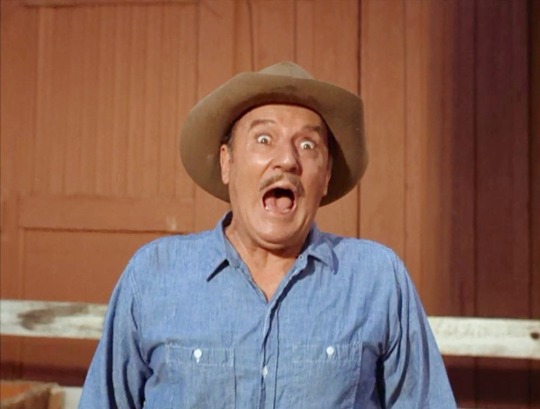
Lucille Ball was an experience rider, having ridden horses in her films and television shows, but here (at age 59) leaves the riding to her children. She does, however, help Harry rope a calf for branding, but only manages to brand Harry instead!

Lucille Ball wears tinted glasses for the exterior shoots, just as she did the previous year on location at the Air Force Academy at the start of season 2. These lenses allow viewers to still see Lucy’s expressive eyes, but also provide protection from the sun’s rays.
Lucie and Desi Jr. were sent to horse trainer Glenn Randall to learn how to ride the dancing horses used for the episode's finale. Randall famously trained Trigger, Roy Rogers' horse.

Lucie Arnaz later recalled, “We would drive two-hours in rush-hour traffic all the way up to this mountain where we get on with this horse dressage and learn from scratch how to ride so that we could do that show with Wayne Newton. I mean stuff like that just blows my mind."
For the finale, Wayne sings "I've Got the World on A String" by Harold Arlen and Ted Koehler written in 1932. The song was made popular by Frank Sinatra. Wayne performs this song while on his dancing horse. Kim and Craig are also on dancing horses that perform while he sings.
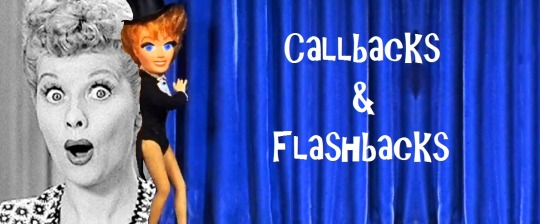
What Happens in Vegas....
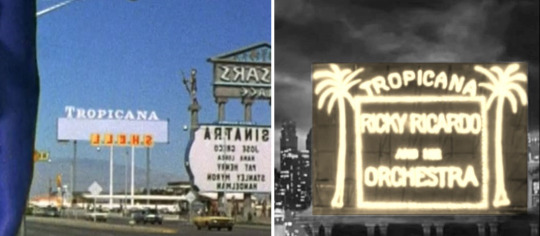
A quick subliminal callback happens in the very first moments of the episode, when Harry’s car drives past the Las Vegas Tropicana. Their sign is only briefly seen from behind [I’ve reversed the image on the left] while the focus is on the Caesar’s Palace marquee. Desi Arnaz borrowed the name from the original Tropicana nightclub in Havana for Ricky Ricardo’s club on “I Love Lucy.” Ironically, the Las Vegas casino hotel opened in 1957, just after Ricky changed the name to Club Babalu. It is still in business today.
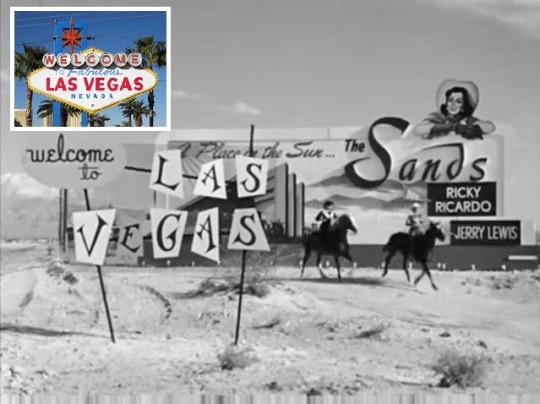
Lucy Ricardo was in Las Vegas for “Lucy Hunts Uranium” (1958, above) hunting for her fortune in the Nevada desert rather than the casinos. The Sands, whose sign is seen in the opening montage of “Lucy and Wayne Newton”, is where Ricky Ricardo performed and the gang stayed during the episode. Location footage featuring the cast was shot in the California desert while a second unit team and cast doubles were filmed in Las Vegas. Lucille Ball and Desi Arnaz were invited to the Sands' fourth anniversary party in 1956.
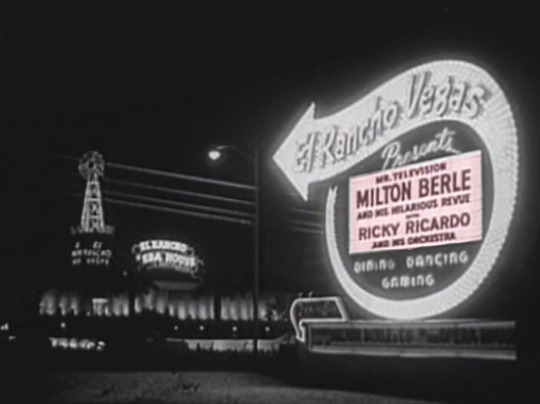
Lucy and Ricky Ricardo were also in Vegas for “The Lucy-Desi Milton Berle Special” in November 1959 on NBC.

Lucy Carmichael and Viv won a trip to Sin City in “Lucy Goes to Vegas” (TLS S3;E17) where being broke doesn't stop them from being high rollers.

In 1975, Lucy Collins traveled to the Nevada gambling town to meet her celebrity crush, Dean Martin, in “Lucy Gets Lucky”, which also begins with a montage of the Strip, ending on the exterior of the MGM Grand, where the action is set.

“Lucy Discovers Wayne Newton” (TLS S4;E14) also was set on Newton's farm and also featured a horse, although not shot on location.

The rear-projection shot of the cast driving down the Las Vegas Strip is visually similar to the now iconic image of the Ricardos and the Mertzes driving across the George Washington Bridge in “California, Here We Come!” (ILL S4;E14), which was the first process shot used on television.

Deja View! As with most rear projection process shots, the Harry’s car passes the same Las Vegas Strip landmarks several times as the scene goes on.

BYOB (Bring Your Own Bass)! Kim surprises everyone by asking Wayne Newton to sing. It is convincing enough that Newton’s brought along his guitar, to a picnic by the river, but it seems a stretch that Tommy has packed his upright bass!

Children & Animals! Working on location with live animals causes a few overlaps in dialogue and a few skillful ad libs by the cast.
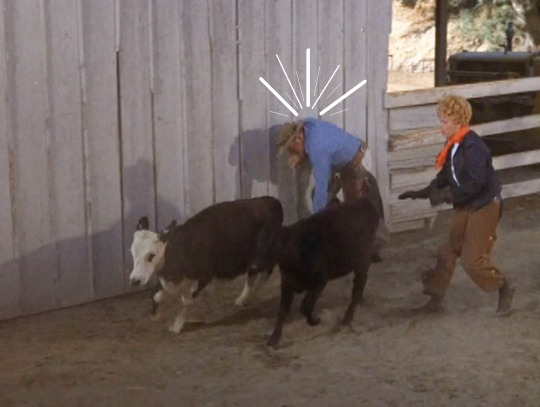
Ouch! Talking of the unpredictability of animals, when Harry chases the calf around the pen, Gale Gordon smashes into the barn wall with his right shoulder. Like the trouper he is, Gordon continues the scene!
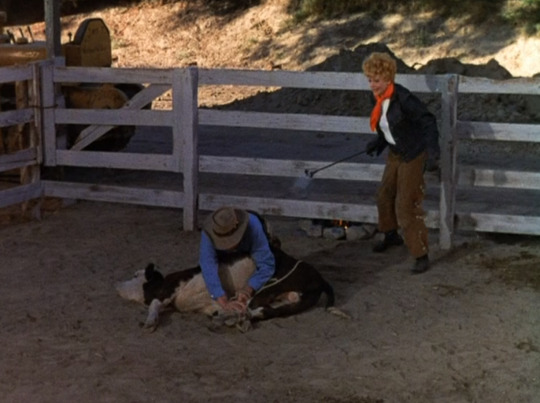
Stunt Roper? When the script has Harry lasso Lucy instead of the calf, the camera goes in for a medium shot of Lucy, with Harry off screen for when the lasso lands around her. It may be that after several attempts, Gale Gordon allowed a more skilled roper to throw the rope around Lucy and then walks into the shot. There is a definite scene change for when Lucy and Harry have (supposedly) subdued the calf in order to brand him. Gale Gordon (63) and Lucille Ball (58) are obviously winded from the scene, but are definitely doing most of their own stunts with the live (and lively) calf.

“Lucy and Wayne Newton” rates 3 Paper Hearts out of 5

#Here's Lucy#Lucille Ball#Gale Gordon#Wayne Newton#Lucie Arnaz#Desi Arnaz Jr.#Jerry Newton#Tommy Amato#Las Vegas#Vegas Strip#1970#Case de Shenandoah#miniature pony#Stardust#Marl Young#International#Riviera#Sands#Bonanza#Frontier#Thunderbird#Flamingo#La Concha#Dean Martin#Pat Paulsen#Abbe Lane#Bill Cosby#Danny Dayton#Milt Josefsberg#Ray Singer
1 note
·
View note